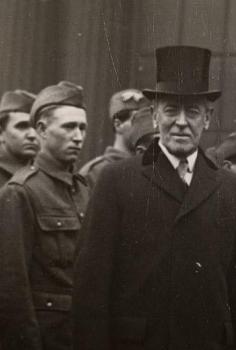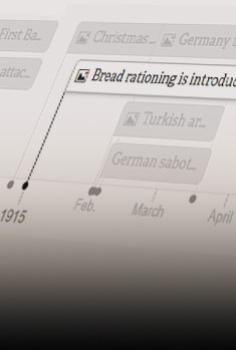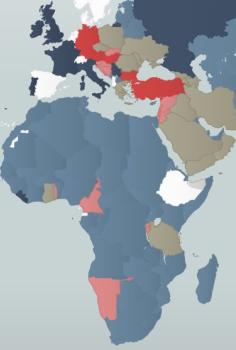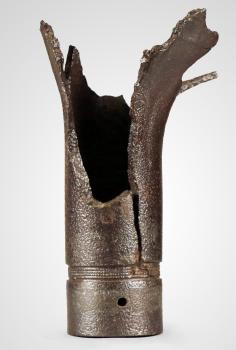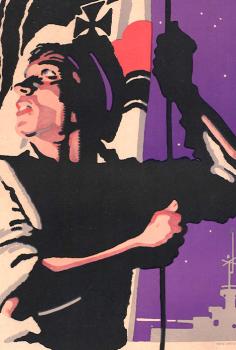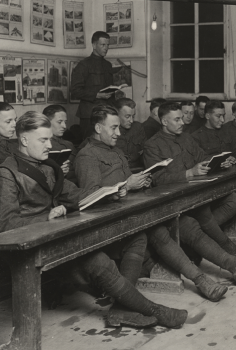Learn why veterans of World War I, in a racially integrated movement, marched on Washington D.C. in 1932 and how they created a camp at Anacostia Park. Explore the short and long-term impact of the protests with Vince Vaise, Chief of Visitor Services of the National Park Service’ National Capital Parks – East. Streamed on Oct. 2, 2020.
Transcript
00:00:00:15 - 00:00:40:14
Lora Vogt
But now it is really my honor and my pleasure to introduce our key speaker for the evening, Vince Vaise, who is a beloved fixture in the National Parks Service. If you take a look anywhere on Google, you will find that he has changed how thousands of people, hundreds of thousands of people think and understand the Star Spangled Banner, the War of 1812.
00:00:40:14 - 00:01:15:15
Lora Vogt
He has recently taken on a new position at the National Capital Parks East, which includes 13 parks sites including Anacostia Park, Kenilworth Park & Aquatic Gardens, the Frederick Douglass National Historic Site, the Mary McLeod Bethune Council House National Historic Site, and others. He is an incredible educator, and you are in for an incredible conversation about the Bonus March this evening
00:01:15:17 - 00:01:32:09
Lora Vogt
and how World War I connects to what was one of the first integrated - and one incredibly influential over the long term - march in and on Washington, D.C. Vince?
00:01:32:11 - 00:01:34:10
Vince Vaise
Hello. Okay.
00:01:34:11 - 00:01:35:21
Lora Vogt
Hello.
00:01:35:23 - 00:01:42:17
Vince Vaise
And see this - got my my helmet on there and got my park ranger uniform there. So we're ready to go today.
00:01:42:17 - 00:01:45:05
Lora Vogt
I love it.
00:01:45:07 - 00:01:50:22
Vince Vaise
I would say let's - that we'll switch over to the video and we'll get started, eh?
00:01:50:24 - 00:01:52:07
Lora Vogt
So look.
00:01:52:09 - 00:02:15:22
Vince Vaise
Can you all see it? Okay, great. Great. So, National Capital Parks East is located in the District of Columbia, and it's one of a number of parks. And when you go there, you'll see a lot of recreational fields. And it's named after the Anacostine Native Americans, in case you're wondering where the term Anacostia came from.
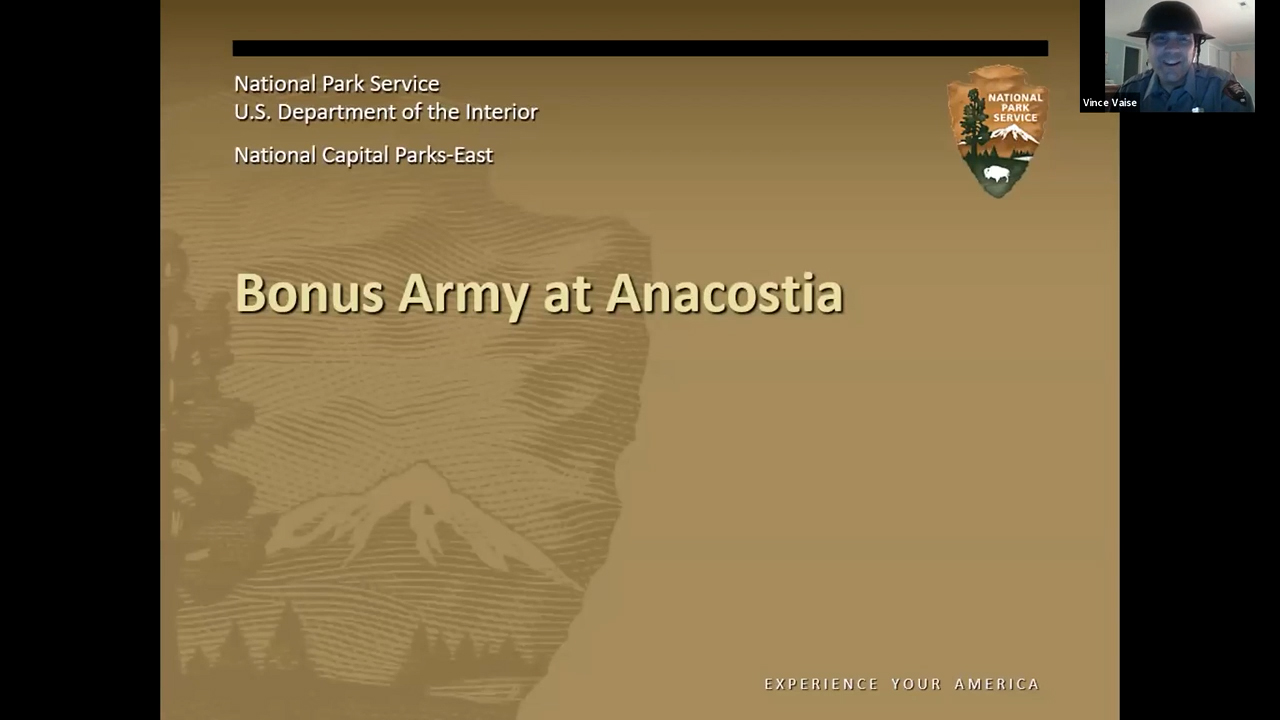
00:02:15:24 - 00:02:44:11
Vince Vaise
And Washington, D.C., is between the Anacostia and the Potomac rivers. And I'll show you a little map on that in a little bit. But what I found about a few weeks after I started working there - I work out of a headquarters building, and I found out that the headquarters building, the sports fields, are located on the exact site of the Great Bonus Army encampment of 1932. And a lot of times, you know, when we study military history, we get into wars.
00:02:44:16 - 00:03:21:11
Vince Vaise
Sometimes people forget to study the aftermath of these conflicts. But I think World War I is - probably a lot of you may already know - has a really interesting history, a very interesting postwar history. And if you forget everything I say today at least remember this one: one real big way that World War I and the Bonus Army encampment at Anacostia, Washington, D.C. relates to us today is Anacostia Park is truly the birthplace of the G.I. Bill.
00:03:21:13 - 00:03:57:10
Vince Vaise
So when we talk about the G.I. Bill, and even veterans today who benefit from the G.I. Bill, that concept germinated in Anacostia Park in the summer of 1932. So let's look at what was this Bonus Army encampment, and what led to that? Okay, so we have World War I, the great - the trench warfare. The United States gets involved in April 1917. It takes a while for the United States to get all the men trained and equipped and out there.
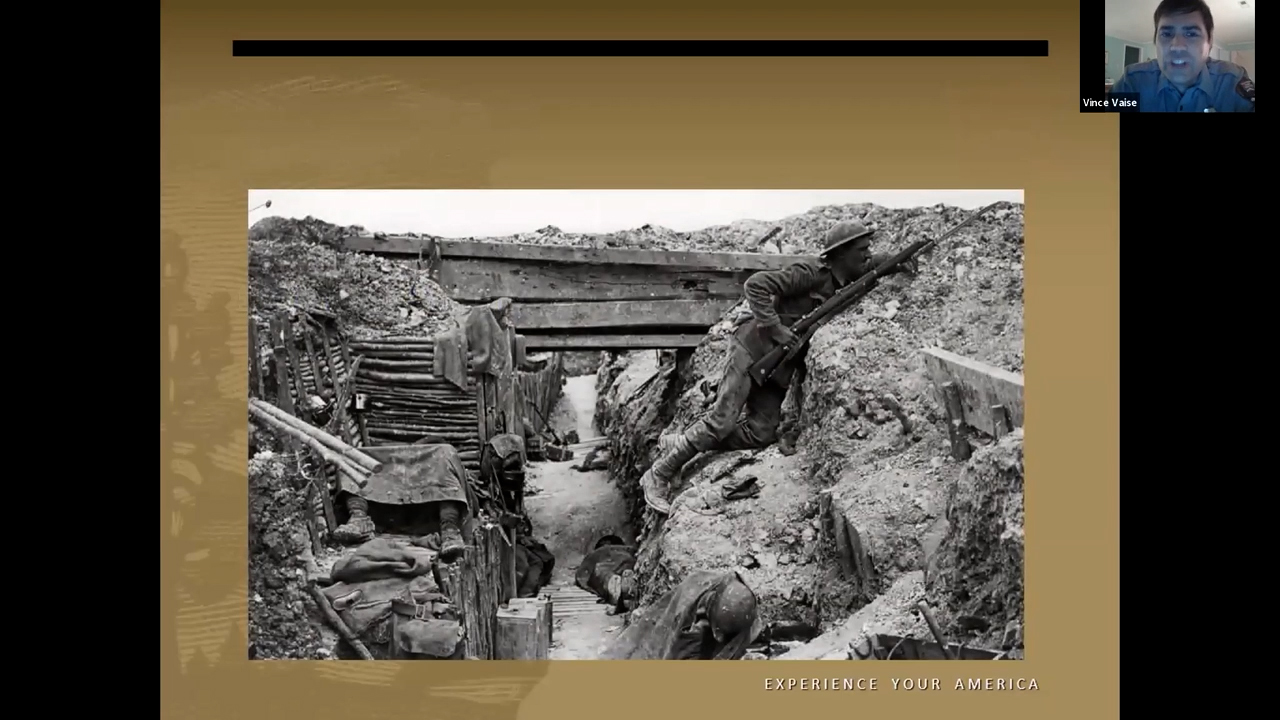
00:03:57:12 - 00:04:23:24
Vince Vaise
And in 1918, in March - in the early spring, mid-spring, American forces start really getting into Europe in huge numbers. And really by the summer months, there's about 10,000 men a day: marching up toward the fields, disembarking, being shipped and being sent over there. About 10,000 a day. So the United States, it takes a while, but when it really kicks into high gear, it moves very rapidly.
00:04:24:01 - 00:04:56:16
Vince Vaise
Down at Anacostia Park, actually, on the other side of the river is the Navy Yard, the Washington Navy Yard. And if you get to go to Washington, D.C., see if you can go. They have a neat museum there. And one thing they have outside is one of those huge naval railway guns. You know, the United States had its battleships, but they actually took the liberty of taking some of those surplus battleship guns and rigging them on huge railroad devices so that they could be fired by rail.
00:04:56:16 - 00:05:20:15
Vince Vaise
So in addition to the U.S. Army in the trenches, you had the United States Navy firing these enormous shells at the German lines. And so 1918 - and then, of course, the Armistice. And when the Armistice comes back, there's this idea that once the men start coming back and going back into society - a few things come to the fore.
00:05:20:16 - 00:05:46:07
Vince Vaise
One is the war ended a little earlier than most people predicted that it would. You know, the Germans caved in there in the fall of 1918, and there was a kind of an expectation that the war would last well into 1919. So it kind of ended a little sooner than people thought it would. The second, and this was actually started by a guy named Bruce Schaefer, Jr. And who was Bruce Schaefer, Jr.?
00:05:46:07 - 00:06:15:14
Vince Vaise
He's one of those interesting people you never hear about. He was a Virginia farmer. His great claim to fame was during World War I widely spreading the idea of substituting potatoes for wheat, which may not sound like a lot to you, but that's really one big way that the civilian population in the United States fed itself. Wheat was a lot more labor-intensive, and with all the guys at the front, they didn't have as much of a workforce.
00:06:15:16 - 00:06:42:02
Vince Vaise
So really substituting potatoes. And he lobbied Washington because he believed that the vets were not paid enough, that even though they were, you know, paid low by the standards of the time - and it was generally expected that veterans being veterans, you don't do it for the money - but even with all that in consideration, it was still very, very low that they were paid.
00:06:42:02 - 00:07:09:05
Vince Vaise
So he started with circulars and mailing fliers and created a movement to have a pay readjustment. Well, this sparked off a firestorm in the United States. Needless to say, many of the veterans were all for it. Many Americans were very much for it. Like, hey, there's one person that said a veteran ought to be able to make enough money to take his gal to the picture show once in a while.
00:07:09:07 - 00:07:33:02
Vince Vaise
And there was this general feeling that they were paid too little. Interestingly enough, there were many that bitterly fought against it. Some of those who fought - and very much against it - was President Calvin Coolidge, who actually said that, you know, basically it would make mercenaries out of the veterans and that patriotism bought and paid for is not patriotism.
00:07:33:04 - 00:08:02:14
Vince Vaise
George Eastman, the famous Kodak guy, he was very much against it. Pierre du Pont, head of the big, you know, manufacturing for the chemicals and everything - he was very much against it. Others, though - like Will Rogers, the famous entertainer, was very much for it. And people started lobbying their congresspeople, saying, pay this. Well, the readjustment got the nickname as a “bonus.”
00:08:02:16 - 00:08:26:22
Vince Vaise
Congressmen started to get behind this movement, but nobody really wanted to pay for it because they believed it would cost about $4 billion to pay it. So the question was, can this be afforded? What would it do to the economy? There was a strong racial component. The idea is that African American veterans would, you know, fritter the money away and mis-spend the money.
00:08:27:00 - 00:08:51:24
Vince Vaise
So, we don't want to give African Americans this money, so nobody should get the money. That was where some politicians argued, from those very grounds. Needless to say, though, this took a number of years. But eventually the pro-bonus faction won. However, the compromise was this: that while the bonus would be paid, it would not be paid immediately.
00:08:52:01 - 00:09:15:15
Vince Vaise
This would be deferred all the way until 1945, ironically enough, not knowing there would be a World War II that would end the same year. And the idea is that if you're a congressperson, well, this works. You get to say, “I was for the bonus, I love veterans. Look, I pushed for the passage of it, and the bill doesn't have - the bonus
00:09:15:15 - 00:09:40:17
Vince Vaise
doesn't have to be paid on my watch. That's for a later Congress to figure out.” So in a sense, you can see how that compromise worked. And that was 1924. However, in 1929, a little bit before the Great Depression hit, Wright Patman - that's the guy in the middle there - took up the cause and started sponsoring bills like, “Hey—” (this is a paraphrase)

00:09:40:22 - 00:10:19:21
Vince Vaise
“This is just not cool. Let's not make the vets wait. Let's pay for the - let's get the bonus paid sooner than later. Let's not make them wait till 1945.” Needless to say, a few months after he starts this effort, the stock market crashes in 1929. And that really exacerbates both factions because the one faction that is - that was - and there are many of those statesmen out there that were against the bonus from the beginning - are like, “Look, you know, the reason we're pushing it to 1945 is we didn't have the money and the economy can't support it.

00:10:19:23 - 00:10:45:12
Vince Vaise
And now with the stock market crash, we really can't support it.” So, you know, no bonus. On the other hand, as time goes on, the plight of these veterans gets more and more desperate. And they're like, “We need the bonus now. We need to feed the families now.” And one thing that I think that's important for us to remember - and I put these pictures up, and if you look at the gentleman with the fedora on the left there: “Wanted: A Decent Job.
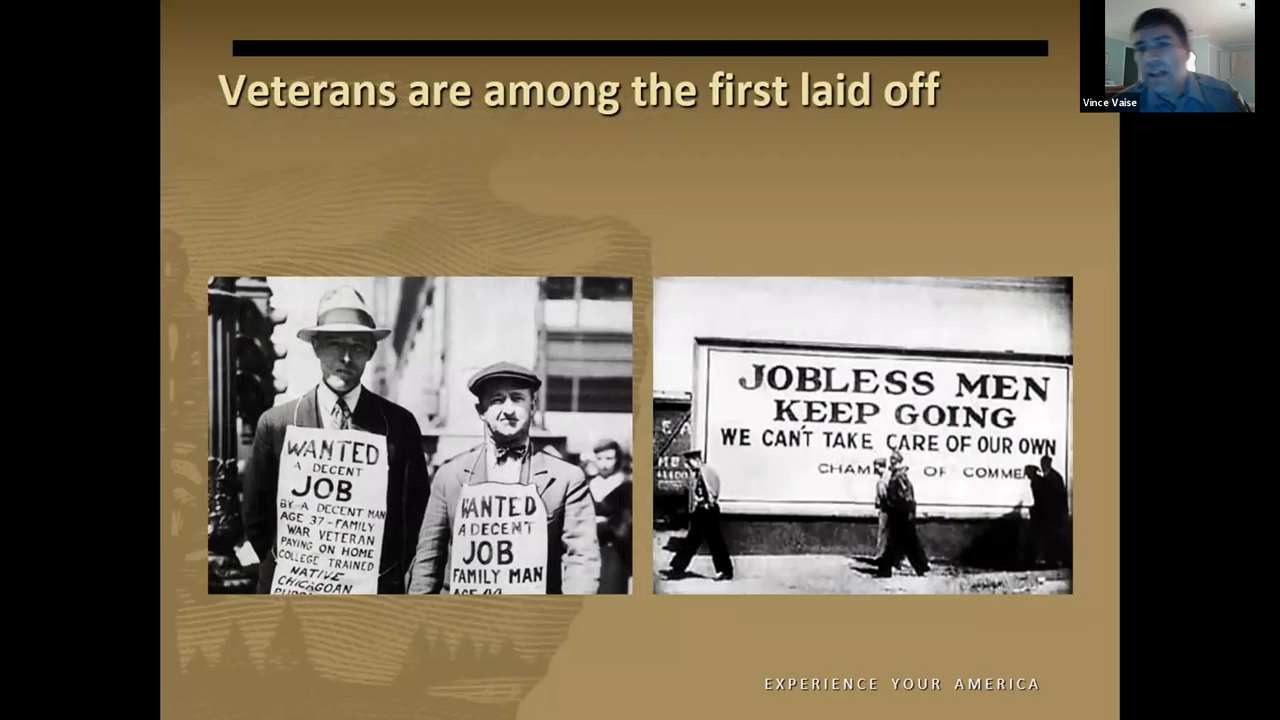
00:10:45:12 - 00:11:19:03
Vince Vaise
War Veteran.” And you see that, and - so these veterans were proud of their service. Now, keep in mind that, then as now - especially in union shops, but in many others, too - they go by order of seniority when it comes to layoffs. So if you're a vet and you're out there fighting in 1918 and you're part of the occupation in 1919, and you don't really get back and settled and back into the workforce until either late 1919 or 1920,
00:11:19:05 - 00:11:49:04
Vince Vaise
and the guy next to you had been working all those years - you're the low person on the totem pole here. So the Great Depression - this really disproportionately affects veterans, as well as African-Americans and other minorities, but especially veterans because they just didn't have the seniority. So in an environment in which pretty much everybody is suffering the effects of this depression, these guys are really taking it on the chin.
00:11:49:10 - 00:12:19:06
Vince Vaise
And you can see signs like, “Jobless Men - Keep Going. We can't even take care of our home.” This creates a groundswell of populism throughout the entire United States. This - the bonus is argued in Legion halls, VFW halls, and then even by charismatic people. And just like our movements today - we're seeing modern movements for various causes on social media, on the internet.
00:12:19:08 - 00:12:41:12
Vince Vaise
Well, the equivalent of that was the radio. Back then, people had radios in their homes. That sounds quaint today. But back in those days, that was like the internet. You could hear someone speaking in California all the way in Florida, and that was a really big deal. One of the more charismatic people on the radio at that time was this Catholic priest, Father Coughlin.
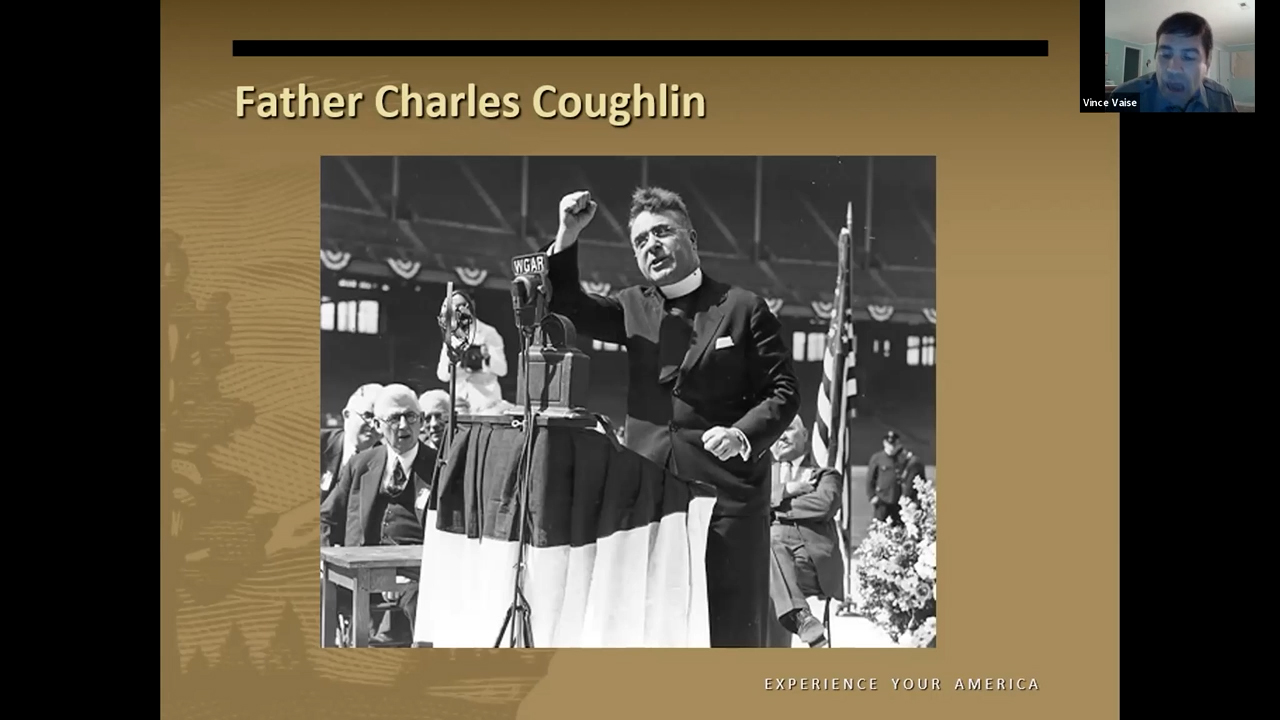
00:12:41:14 - 00:13:20:01
Vince Vaise
And he, in one of his speeches, he argued - he made the analogy - he talks about the “army of joblessness.” He talks about the Great Depression like a great - kind of like a great octopus, with different tentacles taking farms and factories as the army of joblessness. So even in the rhetoric and even in the speeches at the time, this idea of an army of unemployed - an army that's down on its luck - is getting out there, and people are receptive to it.
00:13:20:03 - 00:13:45:00
Vince Vaise
And then enter Walter Waters, who starts the movement that would really become the Bonus Army. So it was just easier - instead of saying the “Pay Readjustment Act,” they just called it “The Bonus,” you know, and veterans were saying it's a tombstone bonus if I have to wait until 1945, I'll be dead and in my grave because I would have starved to death.
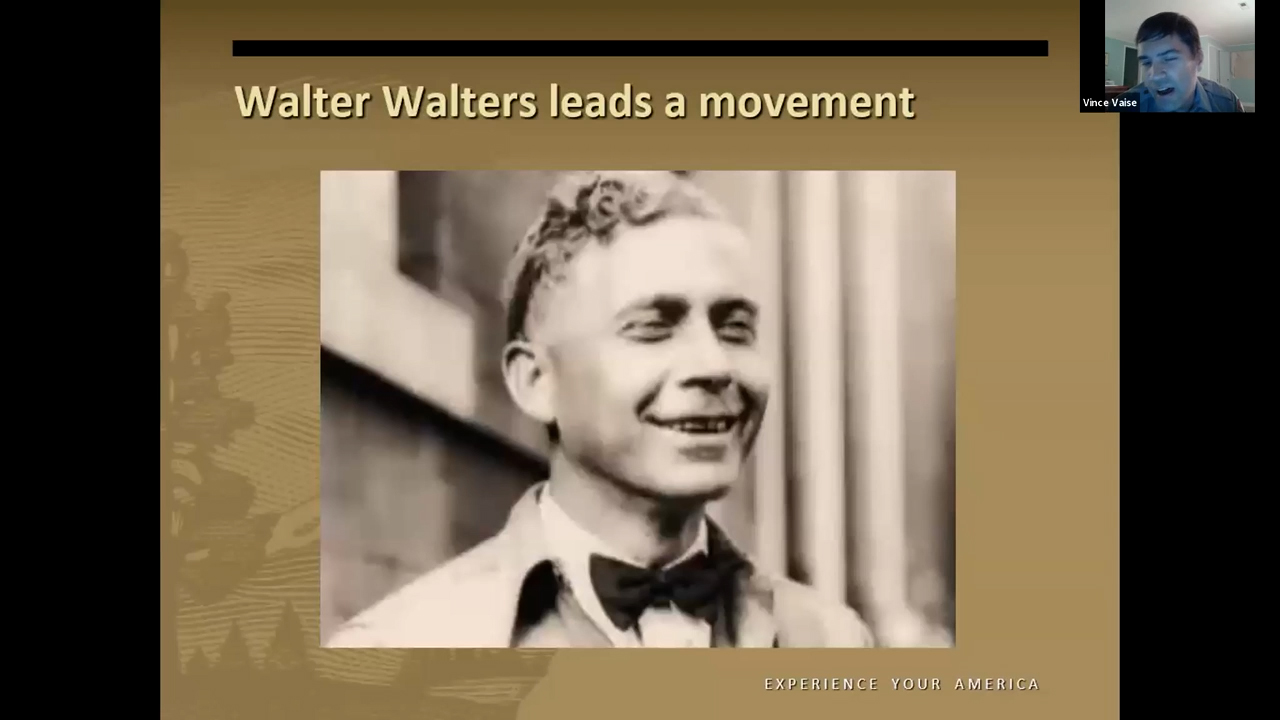
00:13:45:00 - 00:14:07:14
Vince Vaise
That's a tombstone bonus. So the, term was “The Bonus.” “We want our bonus check.” “We want the bonus.” “Pay the bonus now.” And Walter Waters was a World War I vet. He was a sergeant. After the war, he did different things. Farming...I think he worked in a poultry factory and different things. And then he was unemployed during the Great Depression as well.
00:14:07:16 - 00:14:37:14
Vince Vaise
Well, some of the speeches that he started to give - very much stump speeches in the different VFW halls and Legion halls saying things like, “You know, the reason...hey, let's think about this. How come veterans have to wait for their check? How come we have to wait until 1945? You know, United States Steel got paid. The DuPont gunpowder manufacturing that supplied all the weapons and the gunpowder that went into the bullets and stuff -
00:14:37:16 - 00:15:00:02
Vince Vaise
they got paid immediately. All of the big-time defense contractors, they all got paid. The federal government didn't say, ‘Well, you got to wait all these years before you get paid. You get paid immediately.’ Well, why did all that happen? Well, because they had well-paid lobbyists. Camped - literally living in Washington, D.C. - every day, knocking on the door of their state - of their elect -
00:15:00:02 - 00:15:18:18
Vince Vaise
of elected officials, politicians and the like - congressmen - saying we want pay, pay, pay. So what we need to do is we need to go to Washington, D.C., and we need to be there. And if we don't have a hotel, we'll camp out and we will be there and we will incessantly knock on the doors of our elected officials from our different states.
00:15:18:18 - 00:15:37:02
Vince Vaise
And if we get vets from every state, we will make our congresspeople act. So we need to do this.” And at first they're like, yeah, yeah, whatever. Okay, maybe I'll go, I don't know, I can't go because, you know, I got to be here. And then people start asking, well, why? I mean, we're not working here.
00:15:37:07 - 00:16:00:04
Vince Vaise
We're not being paid anything here. We're kind of starving here. So what's the difference whether we're unemployed, not eating here, or we go to Washington and we're unemployed and we're not eating and we're not working. No difference. So let's go. So this movement begins and it - and word gets out through fliers and newsletters, word of mouth, telephone.
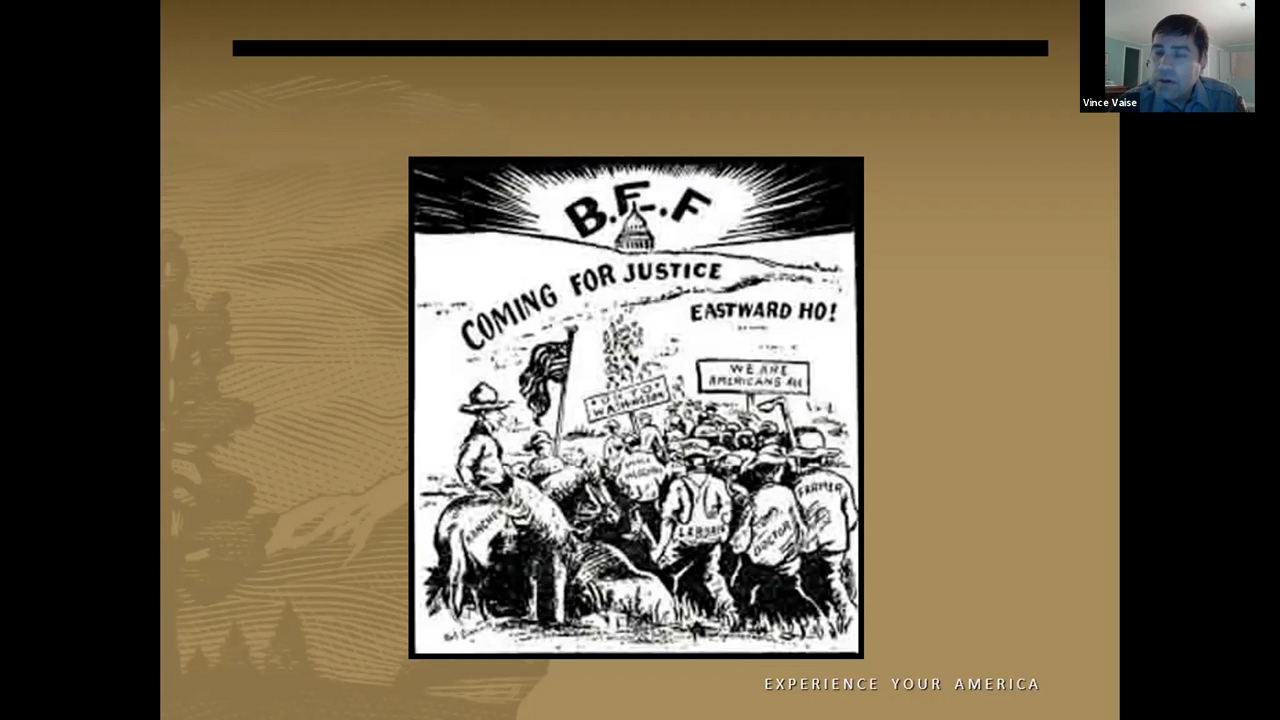
00:16:00:06 - 00:16:35:16
Vince Vaise
And pretty soon veterans from different states - vets from Oregon get the movement started - but soon veterans from New Jersey, Florida, Alabama, all over, they start coming. They start hop - they hop trains. There's one incident, actually, with the Baltimore and Ohio Railroad. (I'm from Baltimore City myself, or Balmer, as we say.) There's one incident where veterans literally formed a human chain on the railroad tracks, and they're like, they told the engineer, you're going to have to mow us down, if you want to
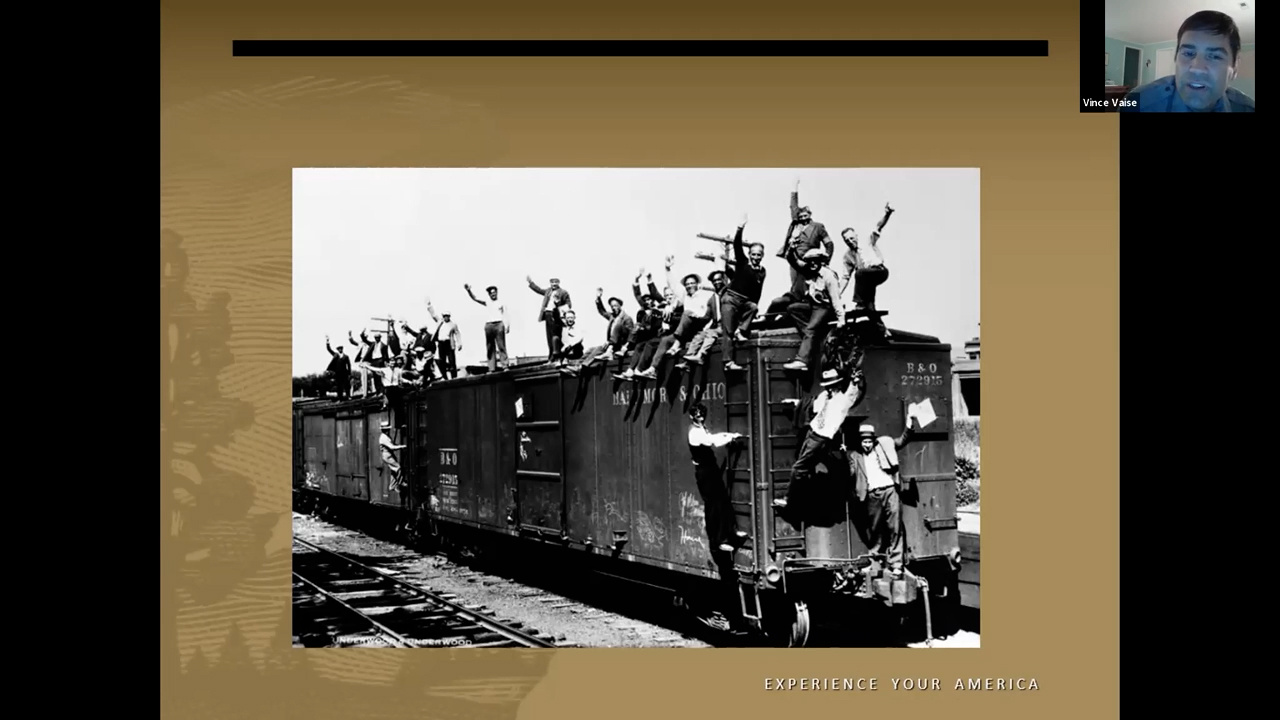
00:16:35:18 - 00:16:59:20
Vince Vaise
keep - if you want to take that train anywhere without letting us climb aboard. And trains were stalled for days and everything, it became a big issue. But eventually people relented. You're like, all right, just ride the train. Get out of here. And the railroad, some of the railroads backed off. In other cases, veterans pooled what little money they had to buy gasoline and trucks.
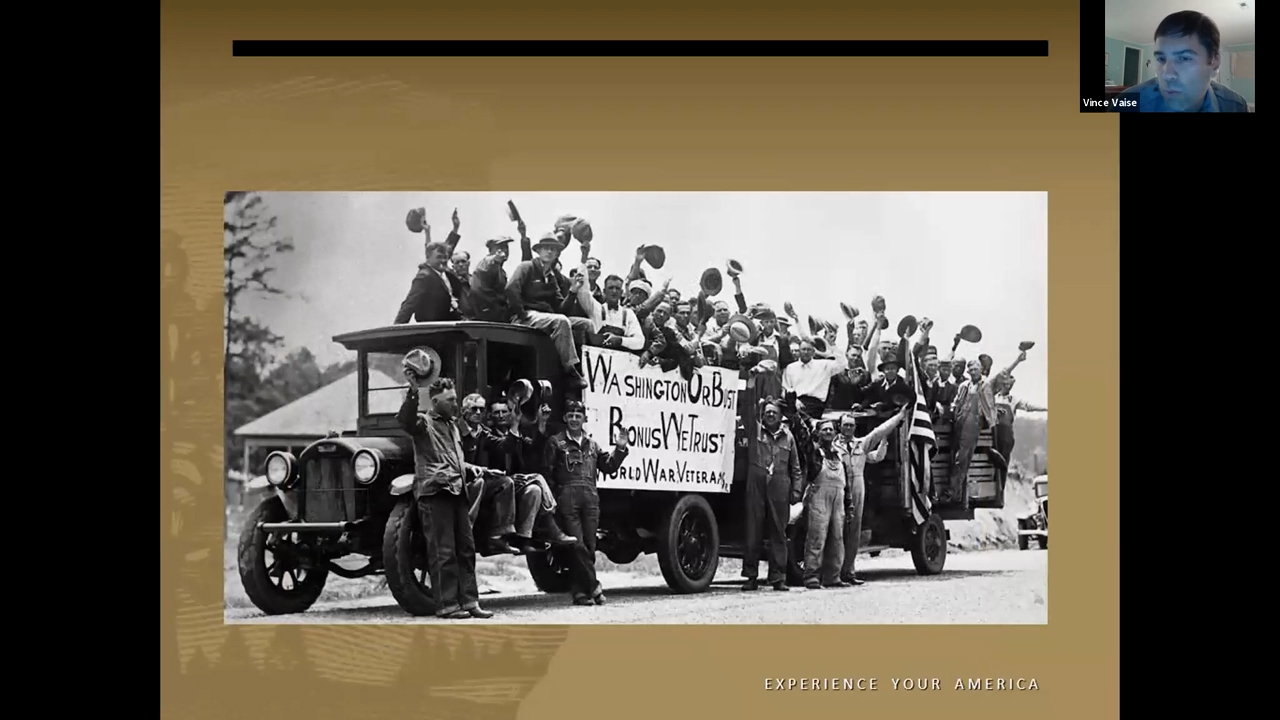
00:16:59:20 - 00:17:22:05
Vince Vaise
And as you can see here, just smush and cram on - and as you see - “Washington or Bust. Bonus We Trust. World War Veterans.” Here you go. So that's how they're going. Sometimes when they would go to little towns one way they could get food is they would tell the town, like, hey, we'll do a parade in your town square today.
00:17:22:11 - 00:17:43:00
Vince Vaise
And sometimes they would bring instruments and have a band, and then the town would feed them as a thank you, give them sandwiches and coffee or a dinner or something. Some towns just did it out of gratitude. Sometimes they would take collections in towns and then buy food. So there were a lot of different ways that they supported themselves as they went to Washington, D.C.
00:17:43:01 - 00:18:07:11
Vince Vaise
Anacostia Park, then as now is a recreational park. So this is the pouring of the dirt in Anacostia, for the baseball fields. Anacostia Park was a segregated park. Half of the park was the African American side. The northern half that had a lot more amenities, like a golf course and tennis courts and things like that,
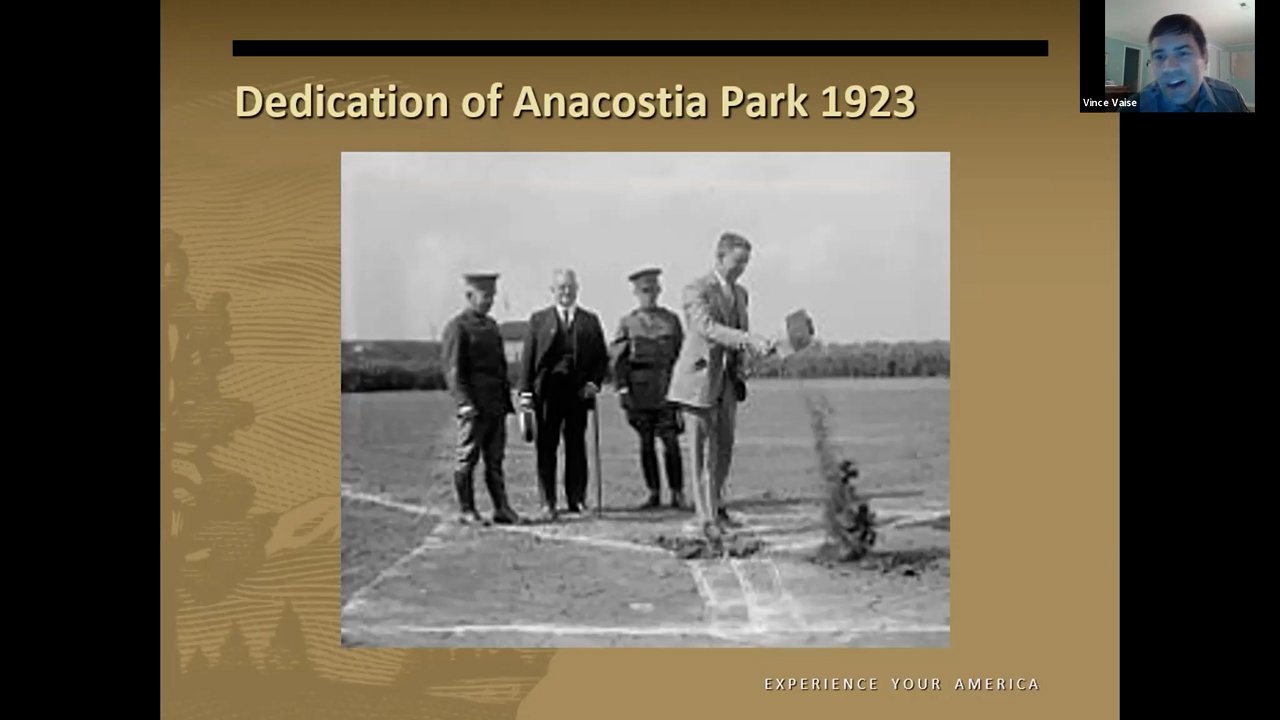
00:18:07:11 - 00:18:35:18
Vince Vaise
that was - and the pool - that was the white section of Anacostia Park. If you look here at this map of Washington, you can see how the Anacostia, the Potomac River flow together, how Washington is in the middle. You can see where the White House and the Capitol building is and where Arlington is. But look over to the right there, all that green that straddles the Anacostia River, all of that is Anacostia Park.
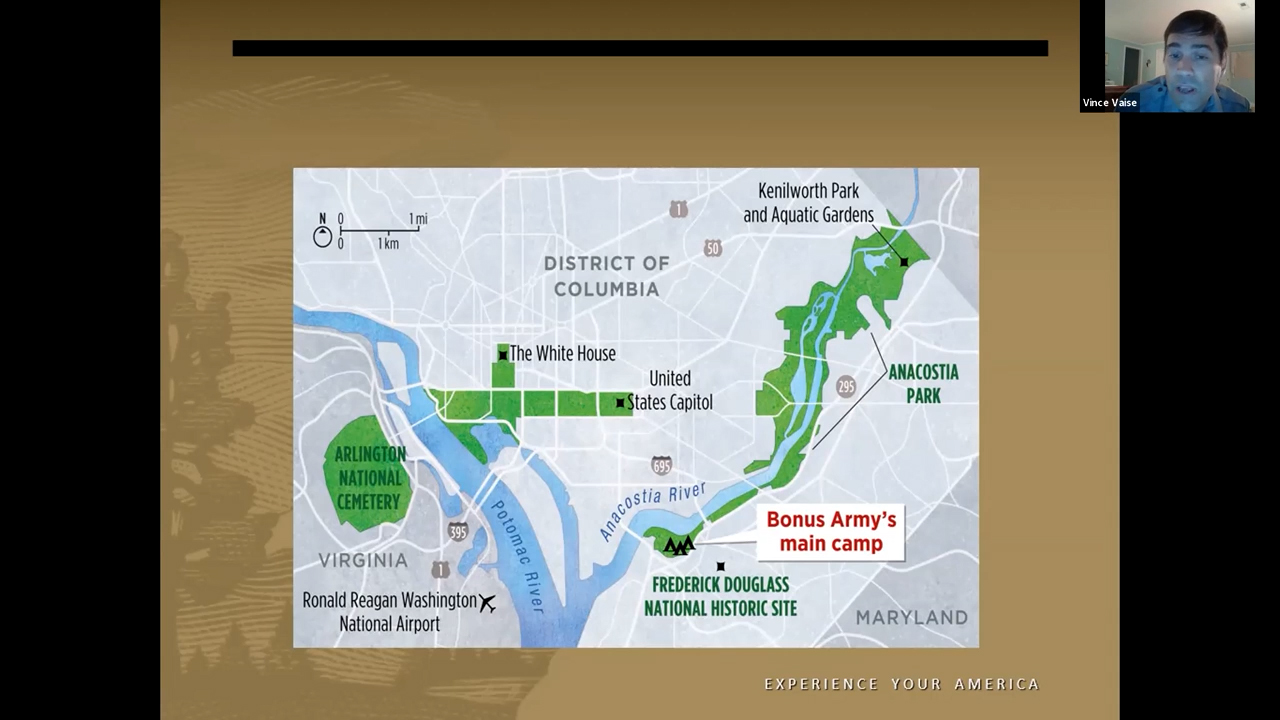
00:18:35:20 - 00:18:58:08
Vince Vaise
And, the southern part of Anacostia Park is the - is where the Bonus Army camp was. I don't know if you can see my little arrow or not, but if you look above the little black triangles down there, you'll see there's two bridges on either side. The one bridge that kind of starts between the letter V and E in the word ‘river’ -
00:18:58:08 - 00:19:20:23
Vince Vaise
that's the 11th Street Bridge or the Navy Yard Bridge. And when the Bonus Marchers with the Bonus Army arrived, they put them down there. And that part of Anacostia Park, that was the African American section. And since it had very few amenities and it was really just open fields, it was very practical for an army to camp at.
00:19:21:00 - 00:19:39:16
Vince Vaise
And then on top of that, the bridge above it was a drawbridge. So they thought if the veterans got unruly, the city people could just raise the bridge and trap the veterans on the east side, and they couldn't storm the Capitol or the White House. There was a degree of fear of what these veterans might do.
00:19:39:18 - 00:20:04:18
Vince Vaise
And no one knew how many were coming. And - but thousands did come. And this put a face on the Great Depression. This was 1932. So, as you know, the Great Depression started in 1929. And people, they all knew the depression was around. But this kind of reignited all of that. Like it's bad enough so many Americans are out of work, the Dust Bowl and all of that.
00:20:04:20 - 00:20:25:08
Vince Vaise
And now all these veterans are really suffering. It put a face to the Great Depression. This made news reels: “The Bonus Marchers, coming from various states in the Union, converging on Washington, D.C. Nobody knows how many veterans will be there, but it's guaranteed to be a large encampment.” One of the heroes that emerges is the person on the motorcycle.
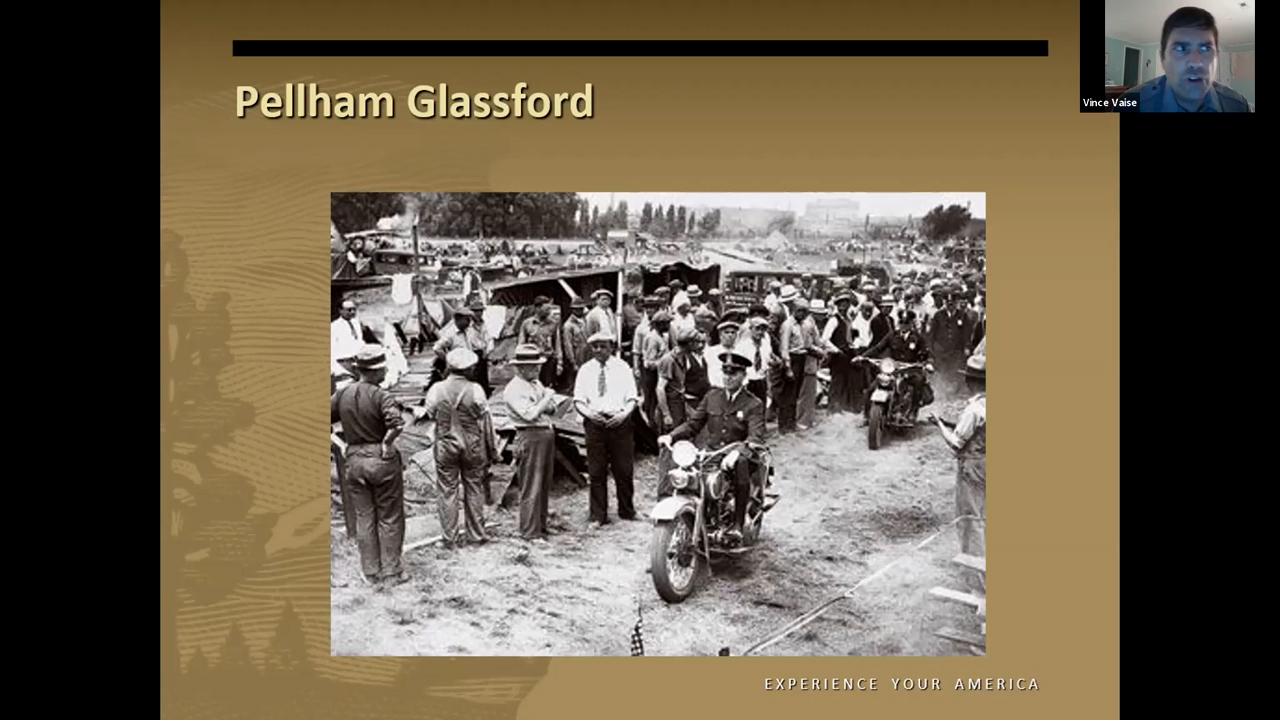
00:20:25:11 - 00:20:59:24
Vince Vaise
And he was the chief of police for Washington, D.C., and his name was Pellham Glassford. And Pellham Glassford really went to great lengths to make sure that there was no violence. In 1932 when this happened, the first veterans arrived in late May, early June, Glassford shelled out well over $2,000 of his own money, which was a huge amount back then, to buy these guys sandwiches, coffee, things like that.
00:21:00:01 - 00:21:30:24
Vince Vaise
As a veteran himself - he was a general, actually, in World War I - he worked to get tents sent down here. So a lot of these guys that had no shelter would have shelter. He made sure the officers did not do anything violent. He made sure the officers played baseball with these vets to build relationships. So he really - if anything, a lot of the leaders of Washington, D.C. did not like him because they thought he was actually too pro-vet in the way he was.
00:21:30:24 - 00:21:54:23
Vince Vaise
However, there was - actually, crime in D.C. went down when the Bonus Army was camping out here in Washington. The camp emerges in early June. The actual first veterans were from New Jersey. And here you can see, you know, some of the early shelters. Those chimneys in the back, that's on the other side of the Anacostia River.
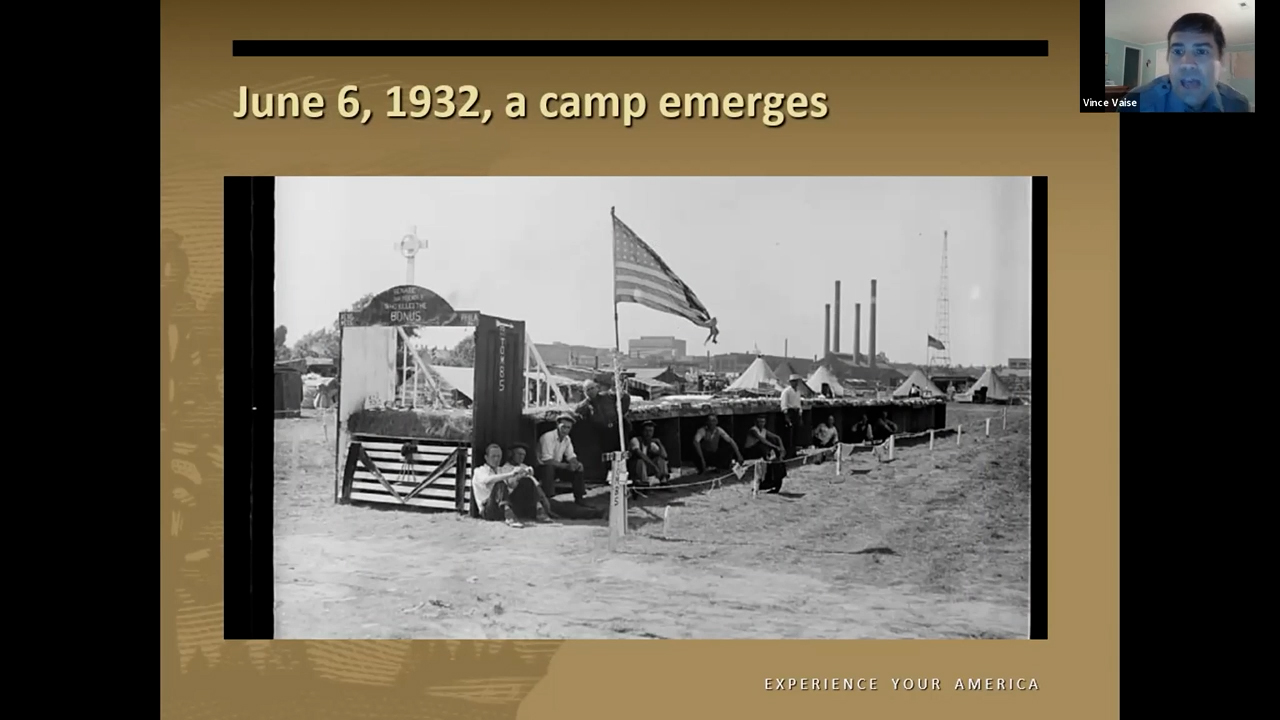
00:21:55:00 - 00:22:20:10
Vince Vaise
That's the Navy Yard where those big railway guns were made. And then if you see those teepee-like tents, those are the army tents that Glassford got for the Bonus Army. So this is how things started as the Bonus Army veterans were arriving in the camp. There were different exhibitions in the Bonus Army encampment to protest.
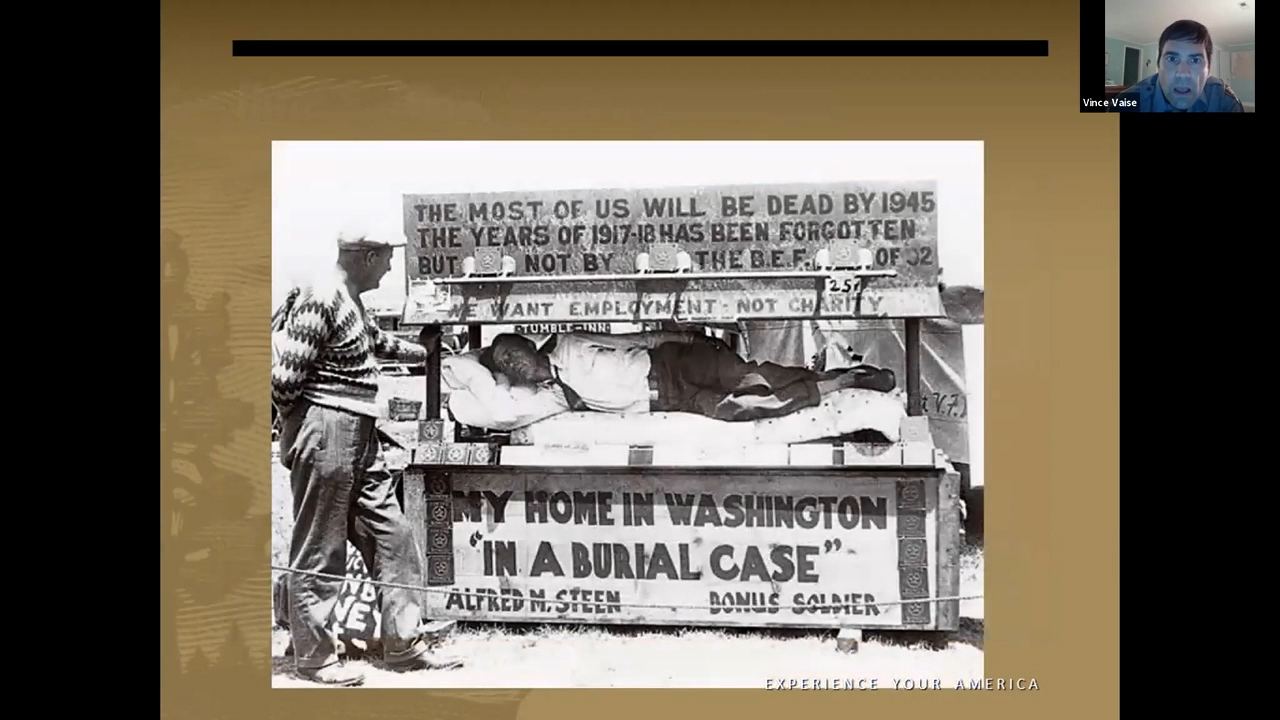
00:22:20:10 - 00:22:50:02
Vince Vaise
And here you can see what I was talking about, the tombstone bonus. You know, “We want employment, not charity.” They call themselves the Bonus Expeditionary Force. Other camps, as you can see. First aid. This was a very well-regulated camp. One, you had to prove you were a vet. If you were not a vet, you could not be in the camp. They had sections of this camp by state.
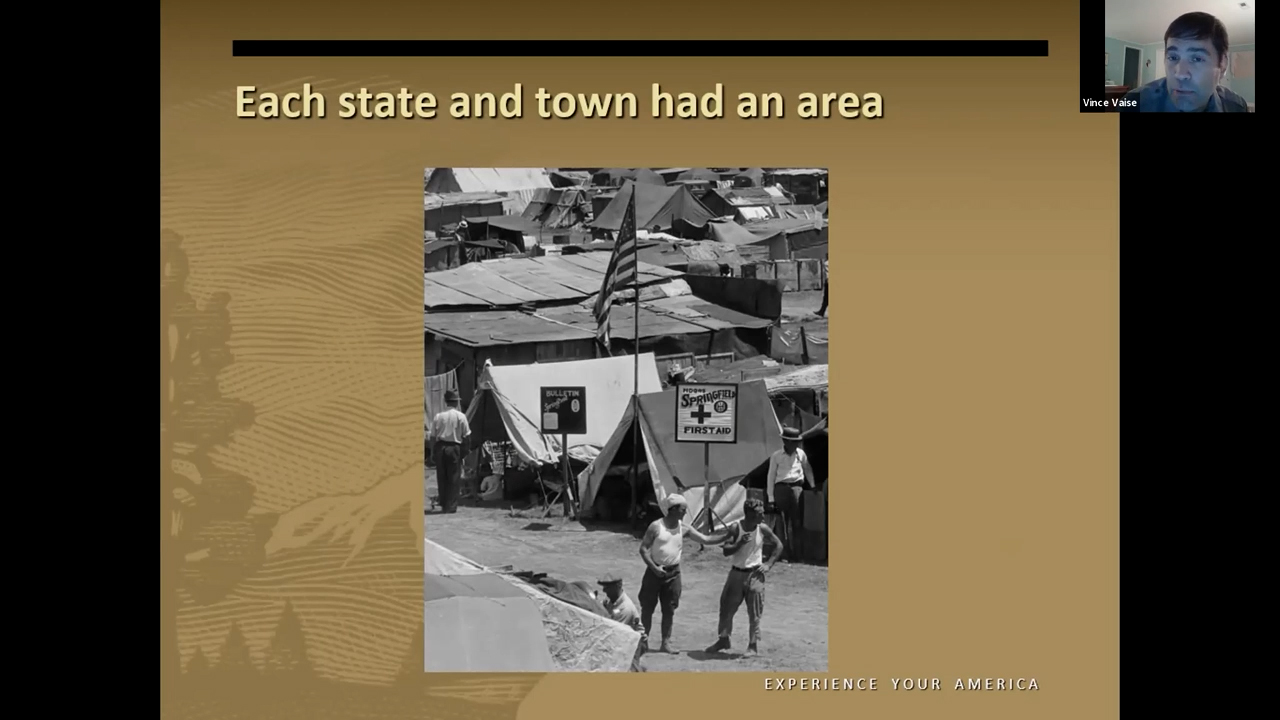
00:22:50:02 - 00:23:12:24
Vince Vaise
It was all organized by state. Streets were given names. I mean, these were vets. They knew how to do this stuff. They imposed a military organization. They made sure that there were no prostitutes, although some of the - many of the veterans did bring their families. And this was also an integrated camp, with African American and white veterans in the encampment as well.
00:23:13:04 - 00:23:38:13
Vince Vaise
And we'll talk about that later. And you can see they even had their own first aid station here. Now, June 8th, 1932 was the Twilight Parade. Well, what was that about? Well, one reason that these veterans chose this particular summer to come to Washington, D.C., is because that's when the bill to pay the bonus early was coming to the floor of the House of Representatives and the Senate.
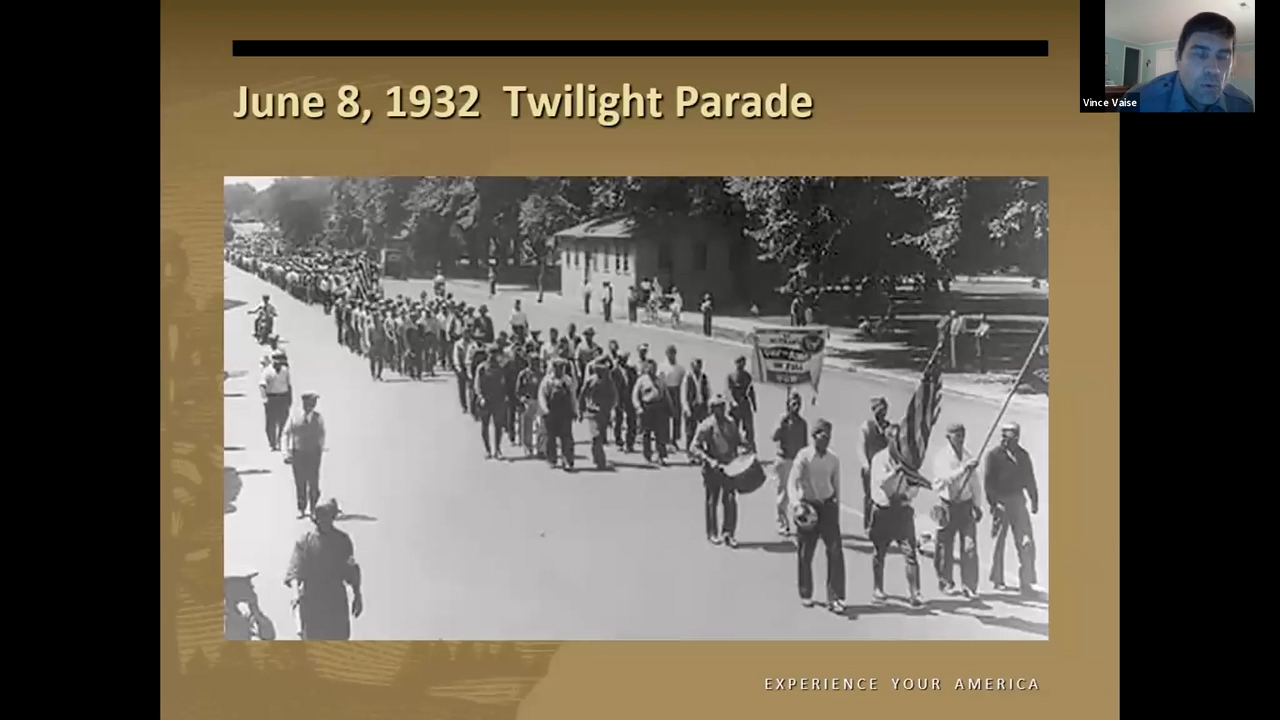
00:23:38:19 - 00:24:09:00
Vince Vaise
So these guys definitely wanted to be in town to make their case heard, to lobby their elected officials and to show the American people that this bill should pass. So, the hearing for the House was early June, not long after June 8th there. So these guys wanted to march in parade shortly before the House would vote on the bill for these vets. They did this really neat parade right up -
00:24:09:02 - 00:24:34:05
Vince Vaise
right down, you know, right through Washington, D.C. Was very peaceful, very orderly. Interesting thing with the Bonus Armies: there were different factions. The biggest group camped at Anacostia. There was a smaller faction of about 300 veterans who were communist, and they were World War I vets, too, but they were not allowed to camp with with these vets.
00:24:34:05 - 00:25:08:12
Vince Vaise
They had to camp in another section - actually not far from where the Smithsonian is on the National Mall. There were two other Bonus Army encampments that were small. One, actually not too far from Capitol Hill. And then another one, also near a golf course, near the Jefferson Memorial. At any rate, the veterans - the efforts seemed to pay off, because the bill did pass with flying colors through the House of Representatives.
00:25:08:17 - 00:25:30:06
Vince Vaise
So this gave the vets hope, like, hey, we passed the first hurdle. We did the parade. We made this movement, you know, the bill passed. This is really, really great. And we're going to stay here because we want to make sure - because it's going to be a while before the Senate hears it.
00:25:30:06 - 00:25:56:06
Vince Vaise
The Senate's going to hear this bill in July. And then the president, if it passes, has to sign it. So they're going to camp at least to July. So things settle down. More veterans come. Here's an interesting thing. If you look behind these veterans - this is in Anacostia - you can see they also raided garbage dumps and other places to get scrap wood, corrugated metal and stuff like that.
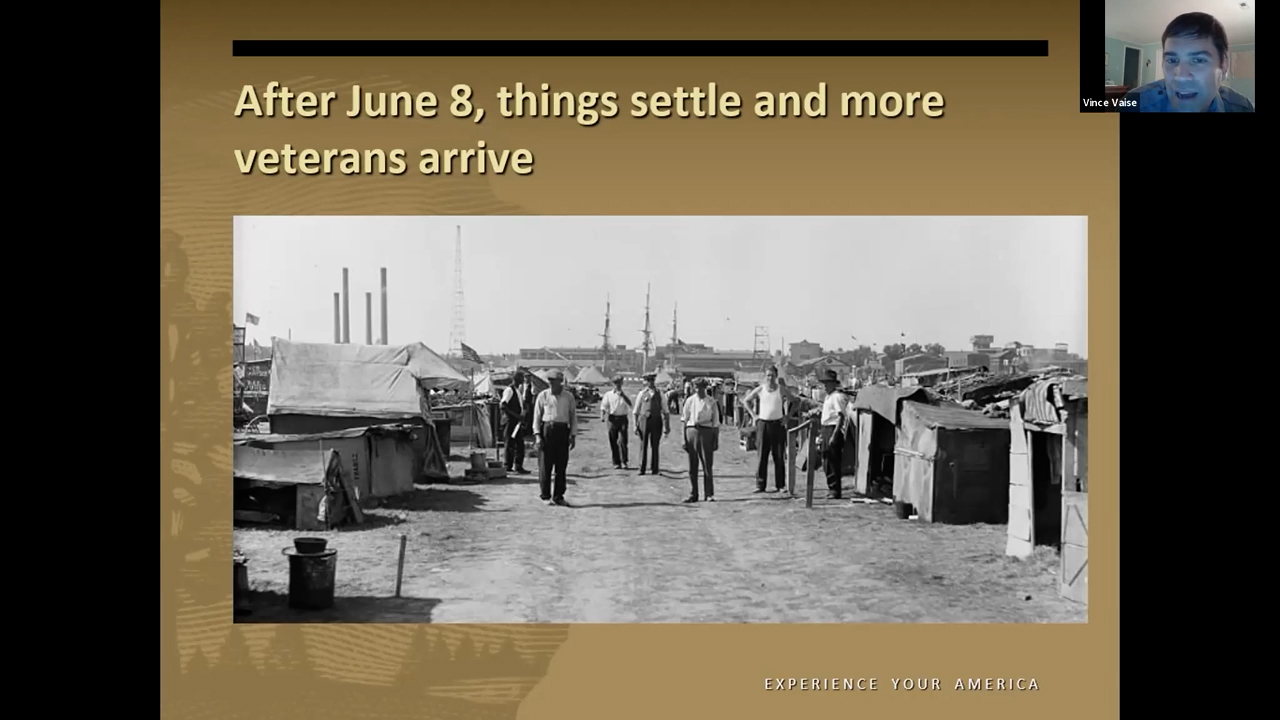
00:25:56:06 - 00:26:17:02
Vince Vaise
So they built shantytowns like the box you see on the right there. But if you look in the back, you see like an old-time sailing ship - that's Old Ironsides, you know, the ship - the Constitution, Old Ironsides, that’s in Boston now. Well, that was being fixed up at the Navy Yard at that particular summer.
00:26:17:04 - 00:26:39:02
Vince Vaise
Interesting note. And you can see how this encampment gets really, really big. Look there, you see the chimneys in the background. Look in the background, you see Capitol Hill, there's the Capitol building. And then look, you can see like this huge city about 18,000 veterans. They built pavilions, as you can see. But look at the guy in the foreground and look at his feet.
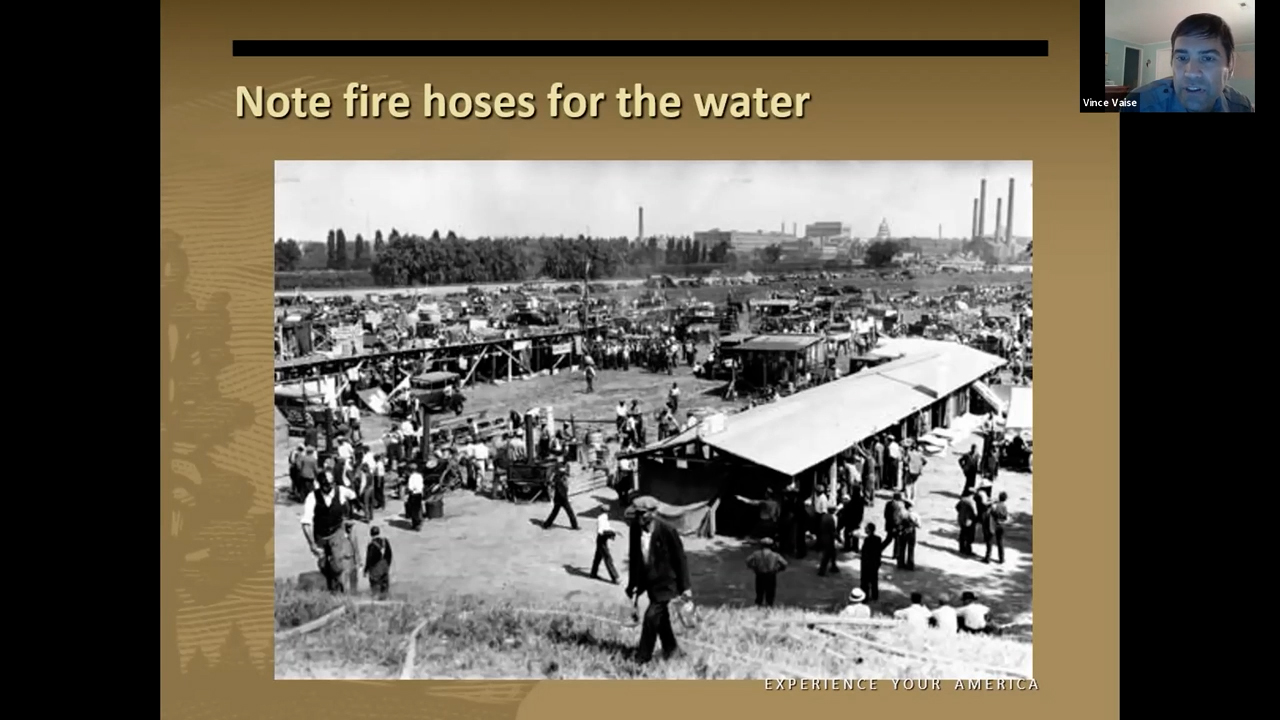
00:26:39:02 - 00:27:01:17
Vince Vaise
You'll see there was these fire hoses. They hooked up fire hoses to fire hydrants. And that's where they got the water, for drinking water. And then you can see there were little field kitchens that were rigged up for food and stuff like that, and trucks and stuff. So there you go.
00:27:01:19 - 00:27:42:22
Vince Vaise
Bathing was done in the Anacostia River. And, the riverfront looks pretty much then like it does now. So that was hygiene: bathing right in the river. And it was an integrated camp, and this was a really big deal. I mean, here, you see African Americans and whites both together. Interestingly enough, the major news networks like NBC and CBS and all that, they were given orders never to film African American and white veterans together unless there was violence and unless there was a riot.
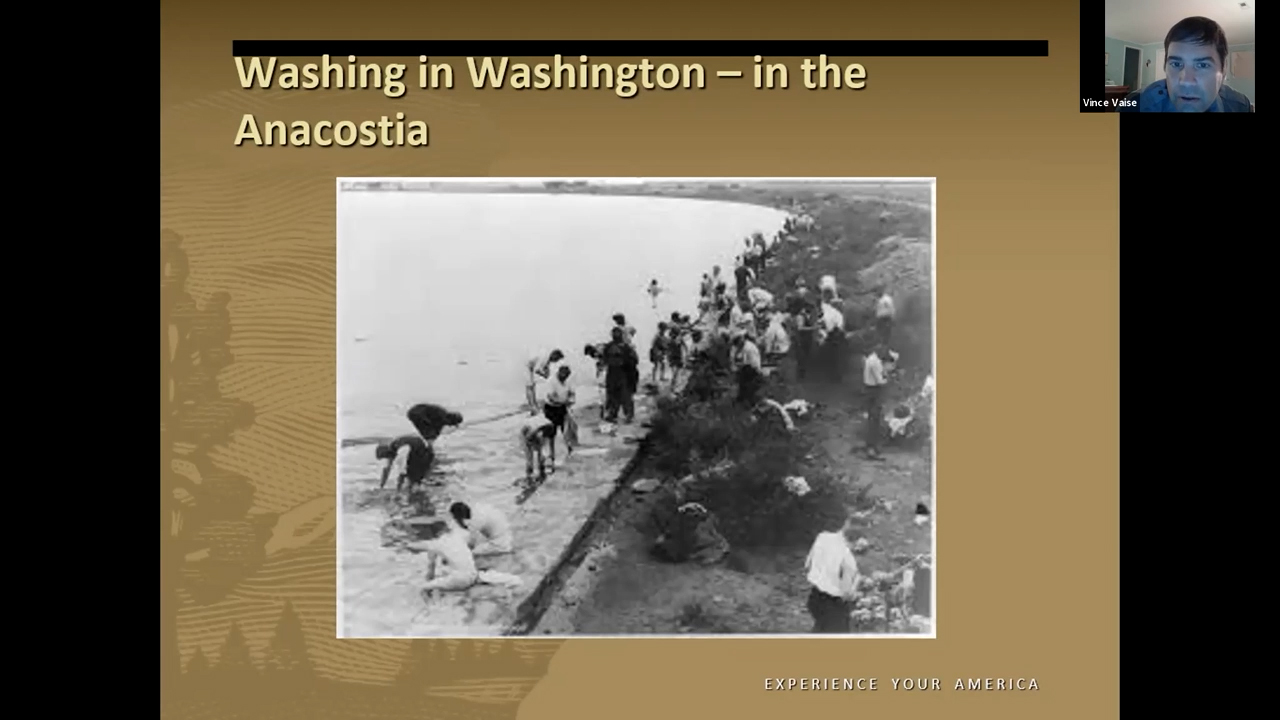
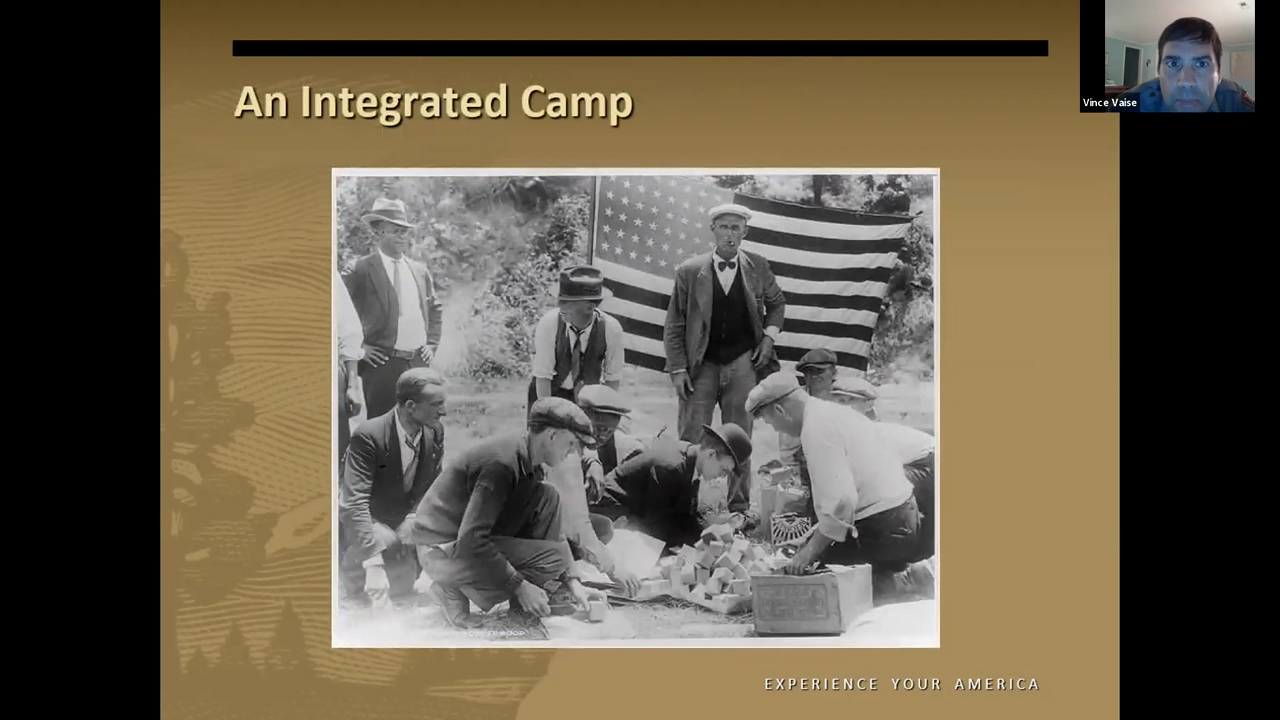
00:27:42:24 - 00:28:03:18
Vince Vaise
So just passing that along. Roy Wilkins was a writer for the NAACP, a very famous writer. And he covered all of this. He said at a lean-to, you would see a pair of black feet and a pair of white feet next to each other. You know, guys just sharing space.
00:28:03:18 - 00:28:29:16
Vince Vaise
You know, space was at a premium, shelter was at a premium. And there was a commonality among these vets. The regular U.S. Army did not want word to get out because the regular U.S. Army was a segregated army at that time. And so this idea that this could happen and come organically, there were a lot of powerful people that wanted to make sure that nobody knew about this.

00:28:29:18 - 00:28:55:03
Vince Vaise
Here's another example. You know, guys getting together, I think he's - I think he started working on the guy’s shoe or putting some ointment, like a little medical station, putting some ointment on his foot. There was a library that was set up. And again, look in the background: again, African Americans, white Americans, a lending library. If you have a lot of downtime, you got time to read.
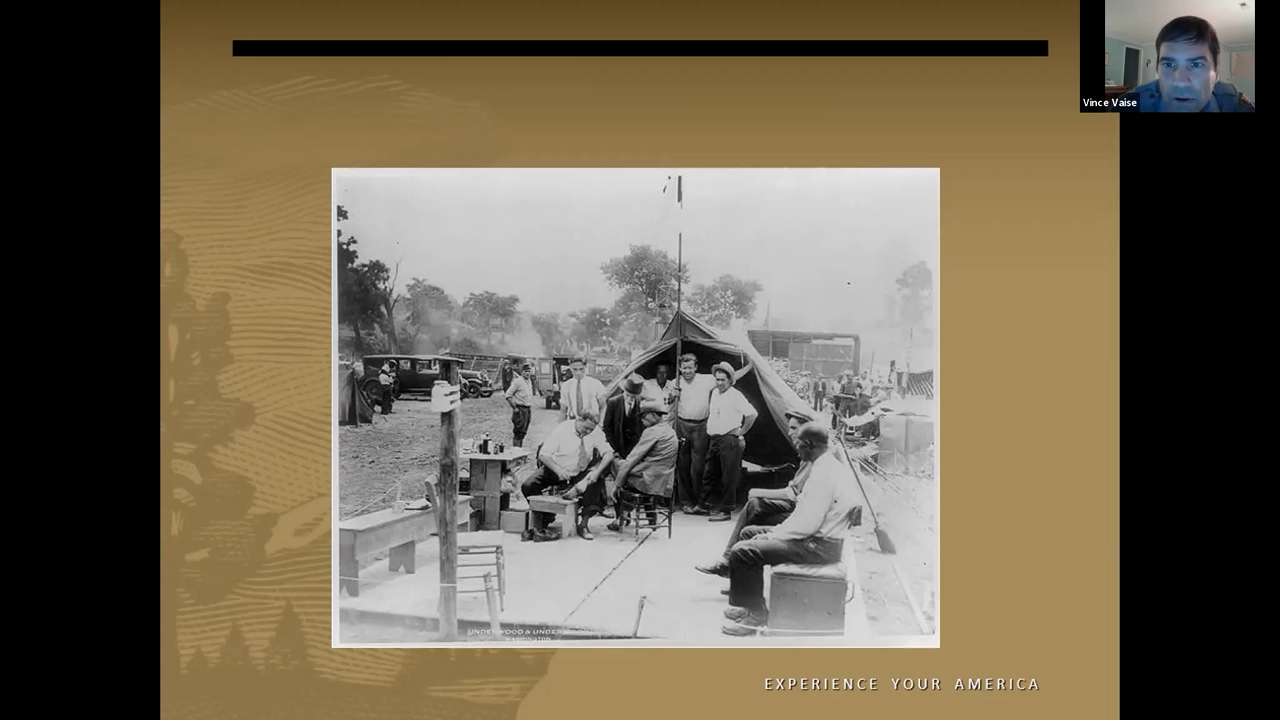
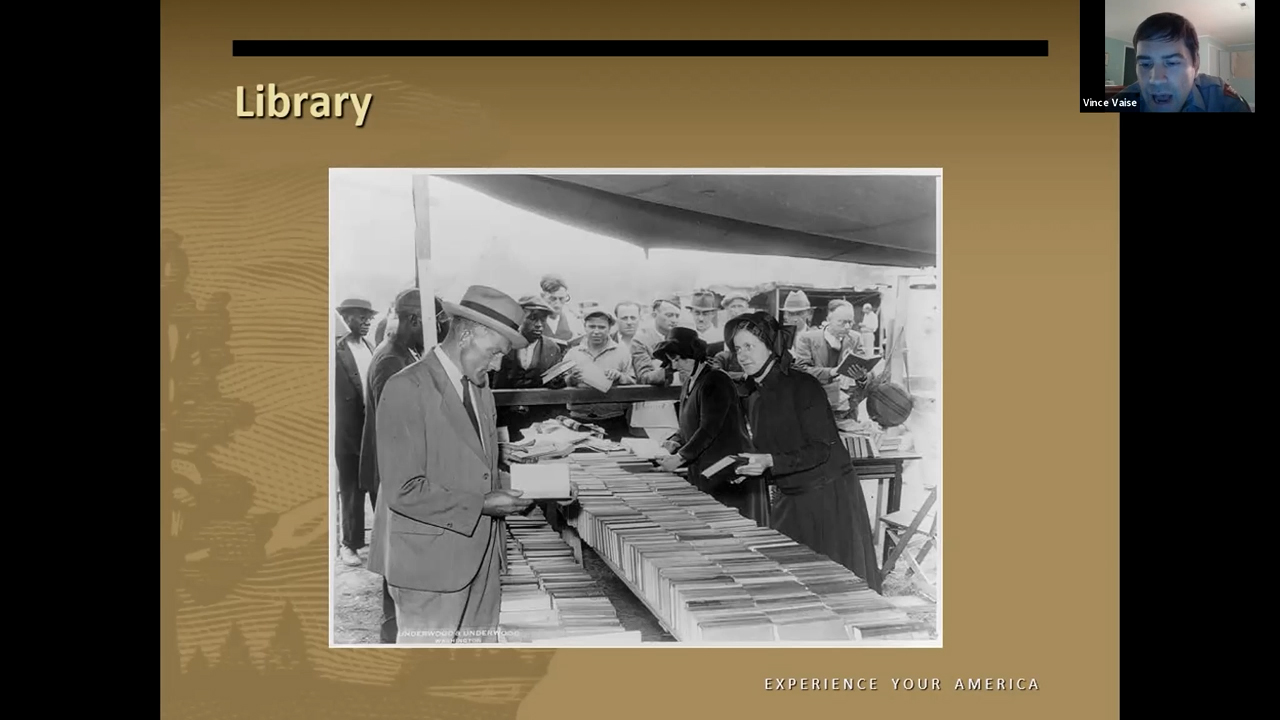
00:28:55:05 - 00:29:24:07
Vince Vaise
There were bands, people brought string bands, banjos. And so there were different concerts throughout the camp. There was a strict lights-out policy at 11:00, though, and there was Reveille in the morning. Chow line. Where did the food come from? Well, people, from nation-wide, contributed their canned goods. And these were ferried down to the Bonus Army.
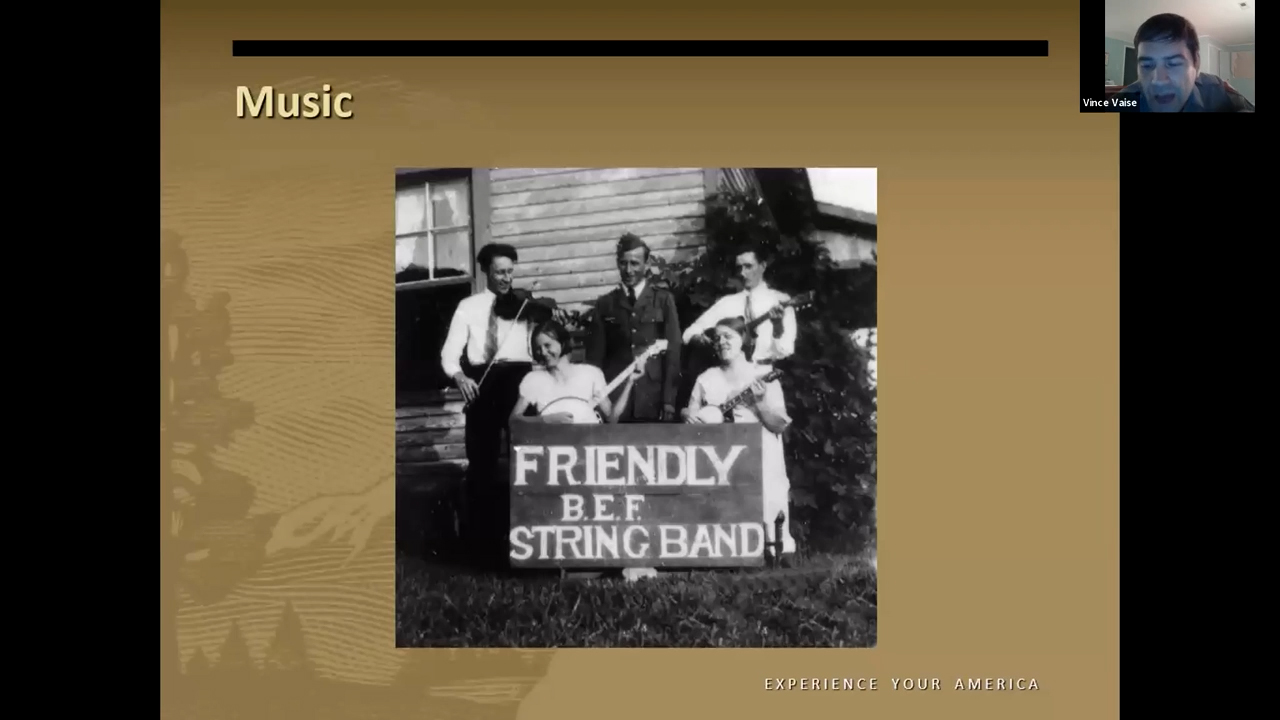
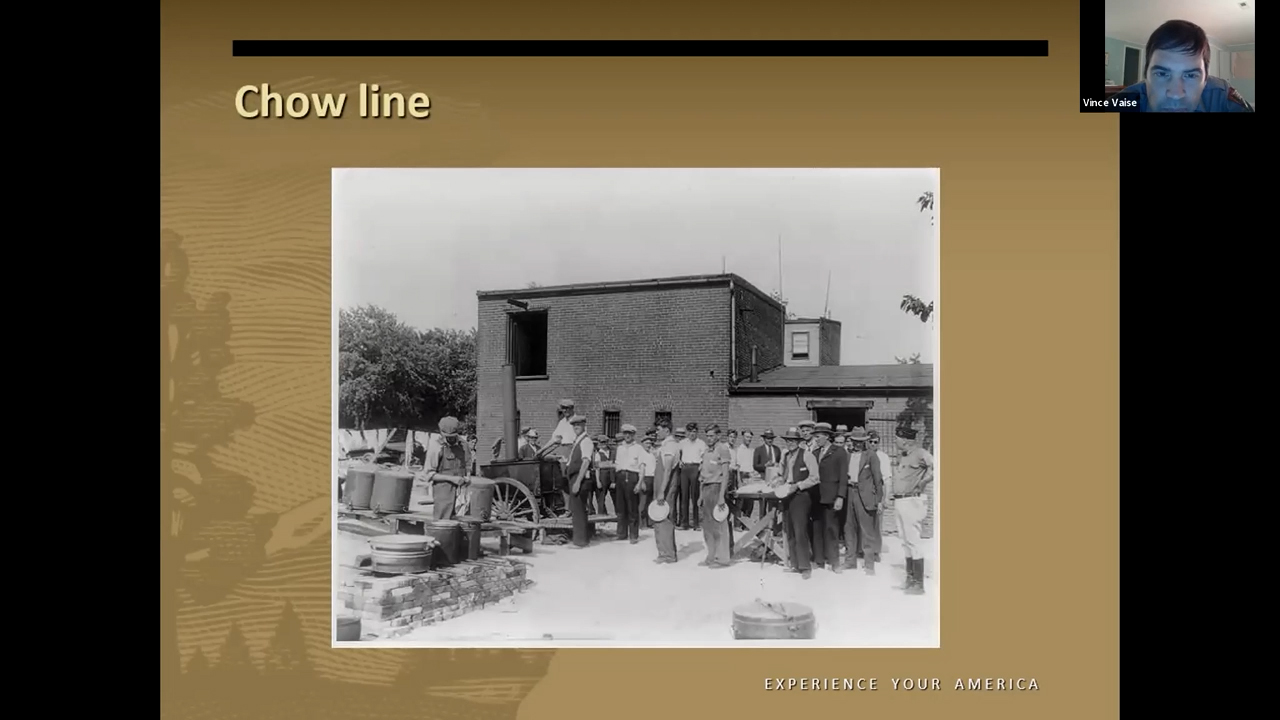
00:29:24:09 - 00:29:50:20
Vince Vaise
And one incident, German meat packers - butchers, I'm sorry, butchers in New York City who actually fought for the Germans in World War I and then later immigrated to the United States, donated a truckload of meat. Father Coughlin, who you heard about earlier, donated $5,000 to purchase food for the veterans. Another colorful figure:
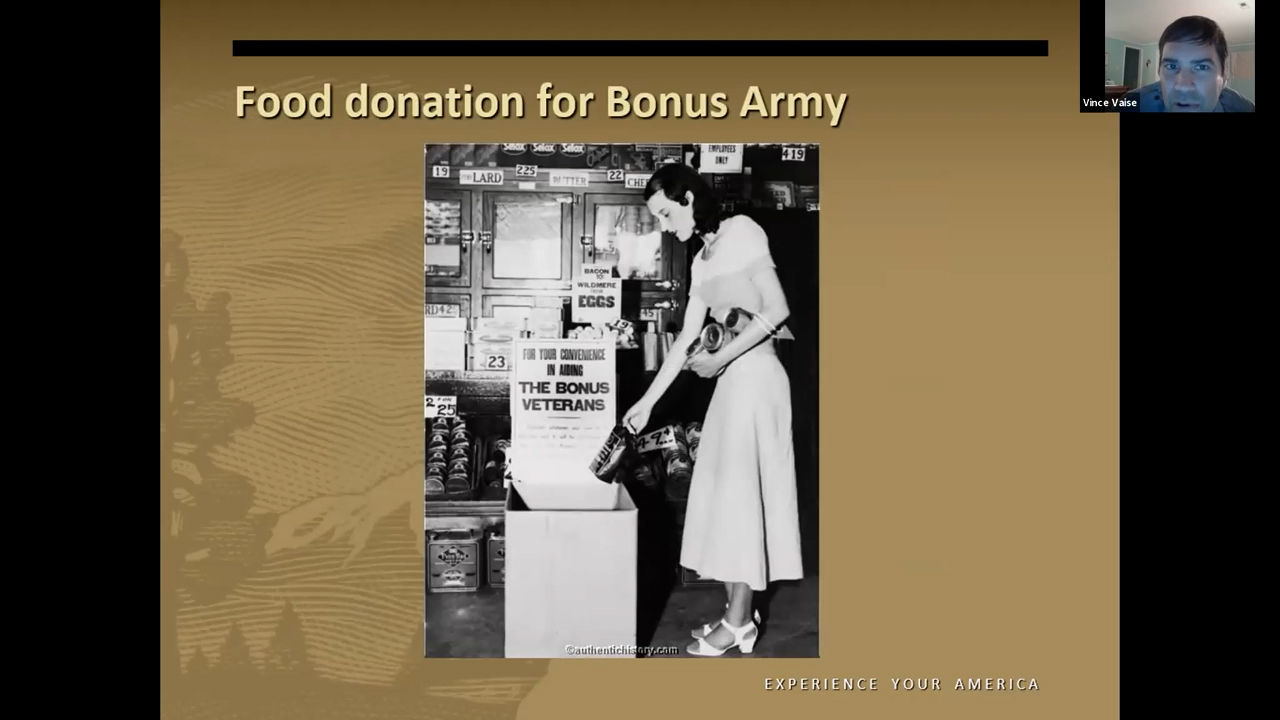
00:29:50:22 - 00:30:18:17
Vince Vaise
Evalyn Walsh McLean. Now, her husband owned the Washington Post, but Evalyn Walsh McLean was really one of the big Washington socialites of the time. And she owned the Hope Diamond, and she contributed thousands of dollars. So here's the Bonus Army. There - Native American vets were there - some in their traditional garb.
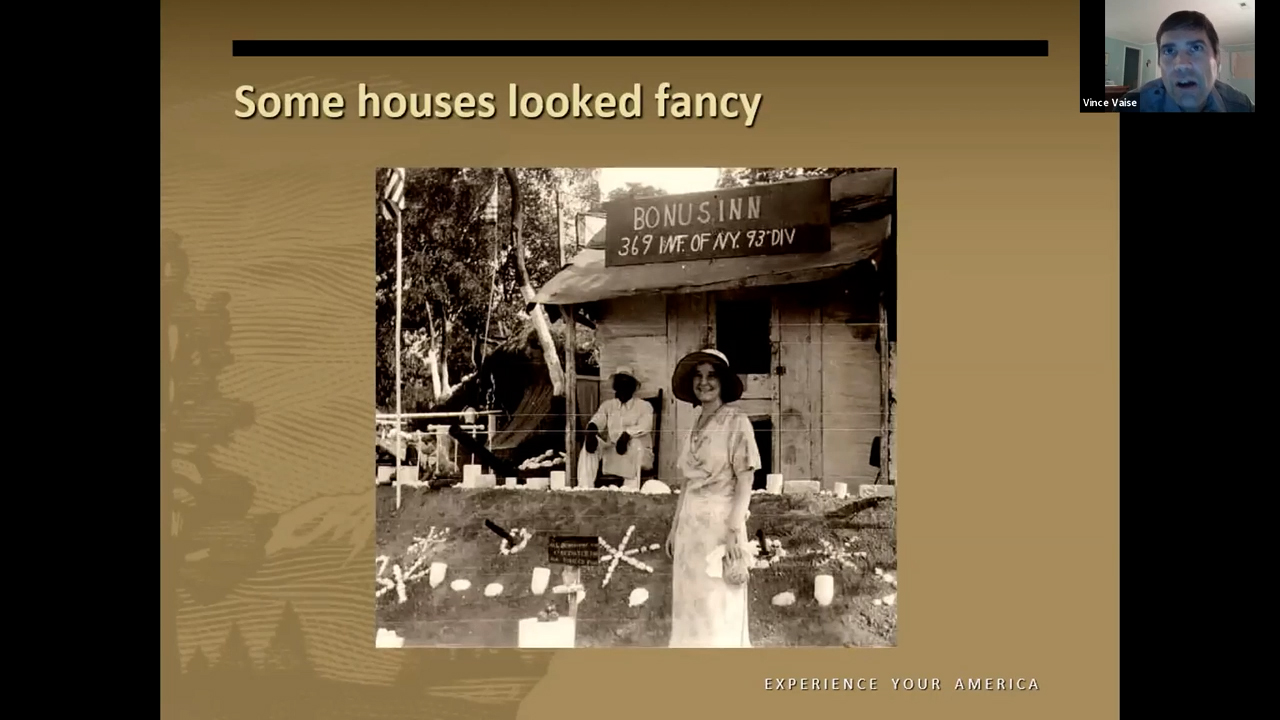

00:30:18:19 - 00:30:43:23
Vince Vaise
They sold postcards, and tourists came to see the Bonus Army - it became a tourist attraction in Washington, D.C. And then here, they built a stage for speeches. One of the more charismatic people who gave speeches was Smedley Butler. And if you’ve never heard of Smedley Butler, he is really one of the most decorated Marines of all time.
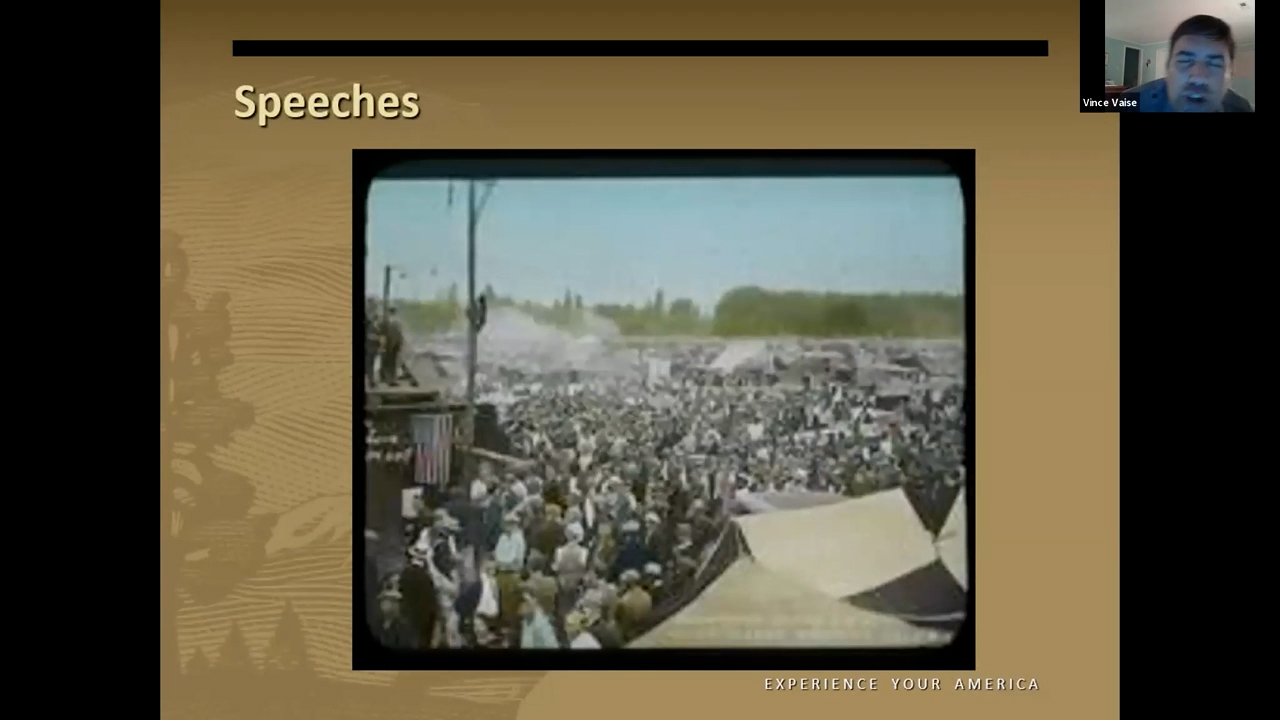
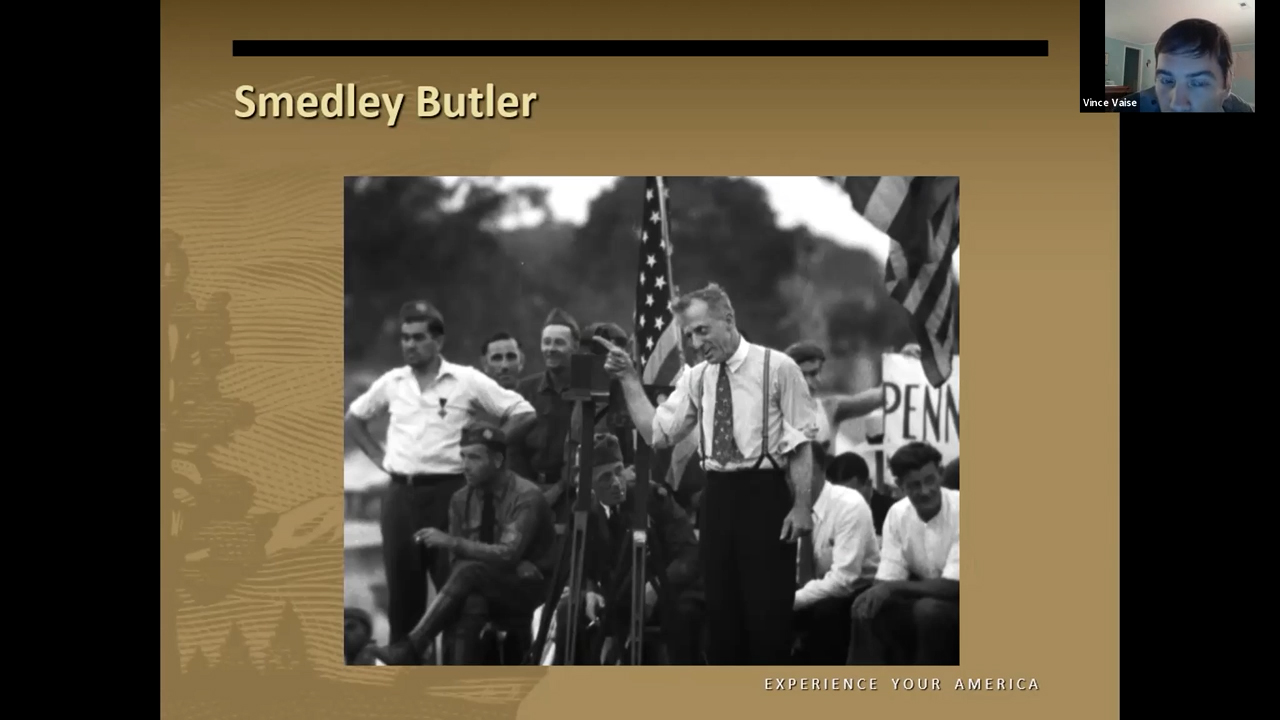
00:30:43:23 - 00:31:17:13
Vince Vaise
He got two Medals of Honor. He would have gotten a third, except Pershing blocked it. Smedley Butler probably would have been better known, except he really came out as very anti-war in general, after he got out of the Marine Corps. He gave a famous speech called “War is a racket” and said that the U.S. military has been used to prop up Third World dictators and big business for a long time, and he's a personal eyewitness of it.
00:31:17:15 - 00:31:37:24
Vince Vaise
And this did not go over well at higher echelons here in the United States. But he was a strong backer of the Bonus Army. He was like, you know, “They didn't call you a bunch of bums in 1918, did they? It makes me doggone mad that they're saying that today.” And these people would give these speeches at Anacostia.
00:31:37:24 - 00:32:11:13
Vince Vaise
And the camp continued to grow. And here you can see these guys were patriotic. They just wanted the bonus, and they just wanted to work through the democratic process to make that happen. There was a second march in July, and this was nicknamed as the Death March, and not because anybody died. Interestingly enough, July 12th - a little late - the Californians arrived, and this was a big contingent from California led by Royal Robertson.
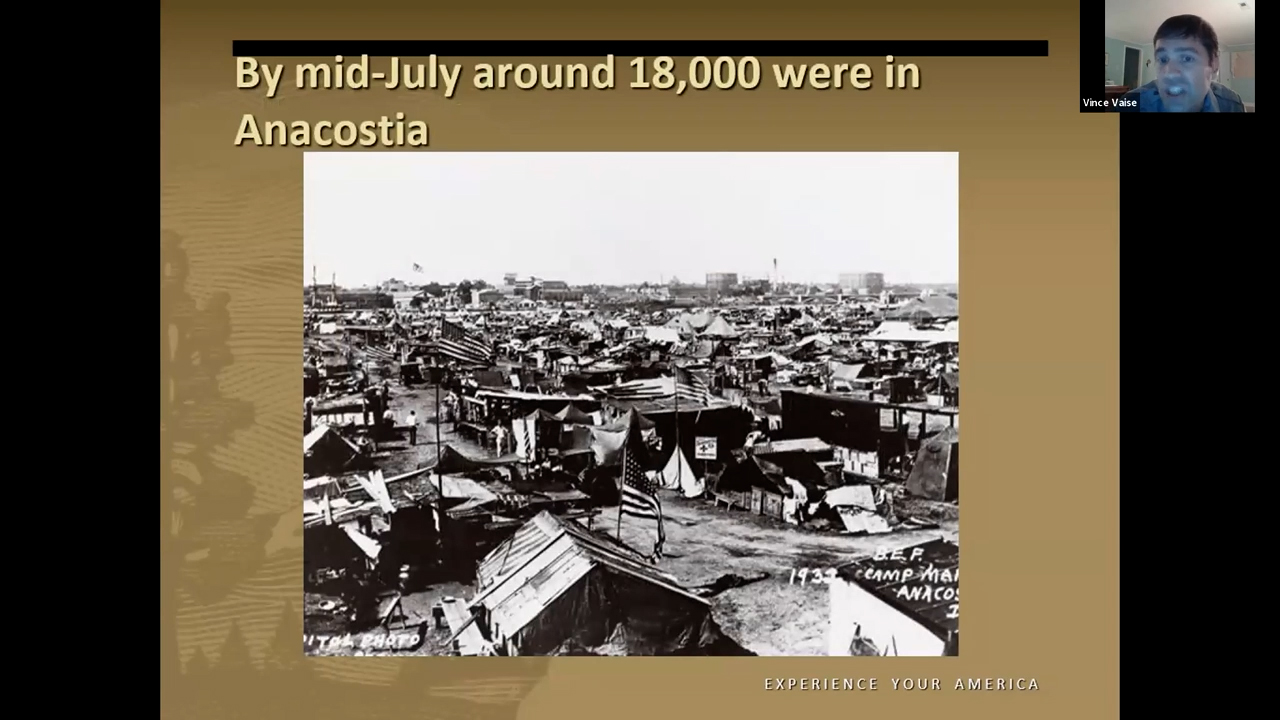
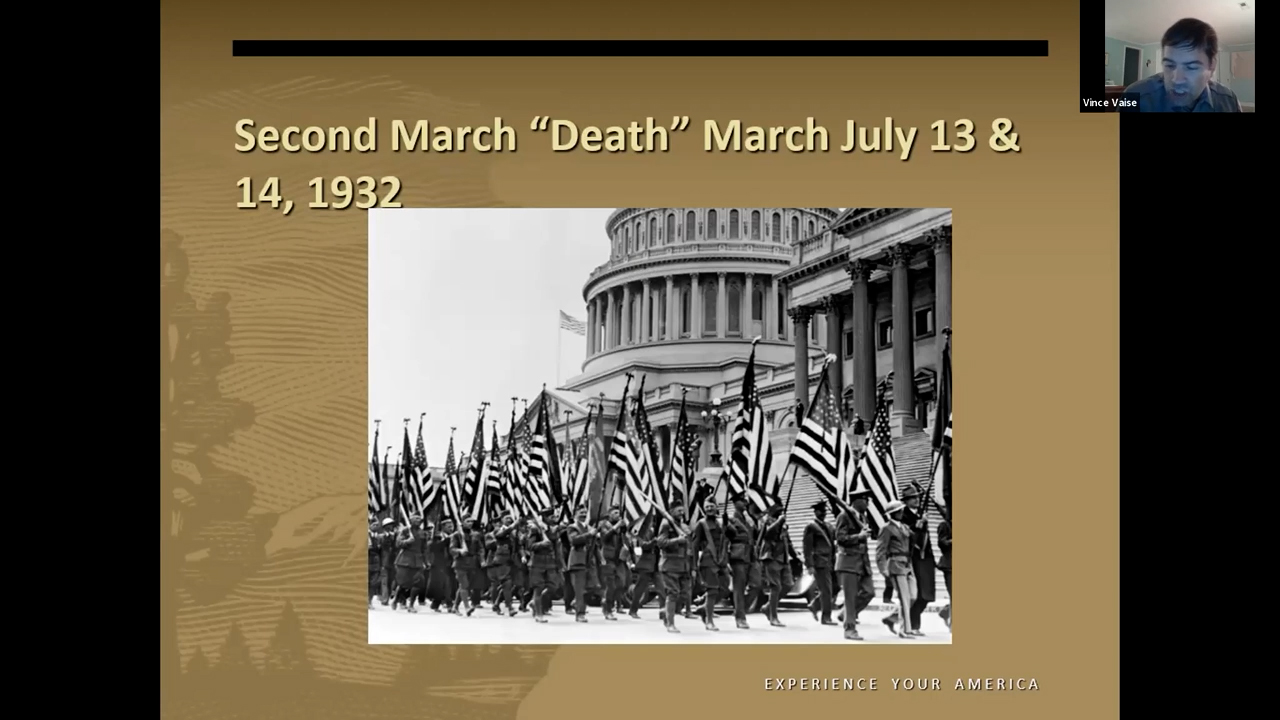
00:32:11:13 - 00:32:35:01
Vince Vaise
He was a vet and a kind of a B-movie actor. These guys started marching in a big circle around the Capitol building. The police went to them. Glassford went to them, said, “Hey, look, guys, you can't camp out on the Capitol. And you can't - you can't, like, sit here, but you can - you are allowed if you keep moving.”
00:32:35:03 - 00:33:08:06
Vince Vaise
So the veterans exploited that loophole and decided to just make a big circle around the Capitol building and just do an endless procession in a circle around the Capitol building. And they had songs like “My Bonus Lies Over the Ocean, My Bonus Lies Over the Sea,” and things like that. So it was a really big deal. In spite, though, of the best efforts, the bill failed in the Senate.
00:33:08:08 - 00:33:26:15
Vince Vaise
And then this is - and then the veterans vow that they're going to camp all summer long. The president boldface said he wouldn't sign even if it passed the Senate, the president being Herbert Hoover at the time. So the veterans were like, okay, well, we'll camp all summer, we’ll camp in the fall, we’ll camp for the winter.
00:33:26:15 - 00:33:54:19
Vince Vaise
We'll just stay here until it passes. If it's months or if it's years. Well, the higher-ups in Washington D.C. - there was no governor of D.C. Essentially D.C. was governed by what they called the electors. And one had to be a Republican, one had to be a Democrat, and one had to be a civil engineer. And so think about it like three governors, okay, who kind of ran D.C.
00:33:54:21 - 00:34:25:05
Vince Vaise
Well, they didn't want the veterans here. They didn't want them here to begin with. And they certainly didn't want them here for a long period of time. And then there was a fear that what if typhus or something breaks out in the camps? Will it spread to the residents? What's going to happen? So once it's evident that the bill is not going to pass or even be brought up any time soon, and then there's a recess, then the city leaders are like, get these vets out of here because nothing's going to change.
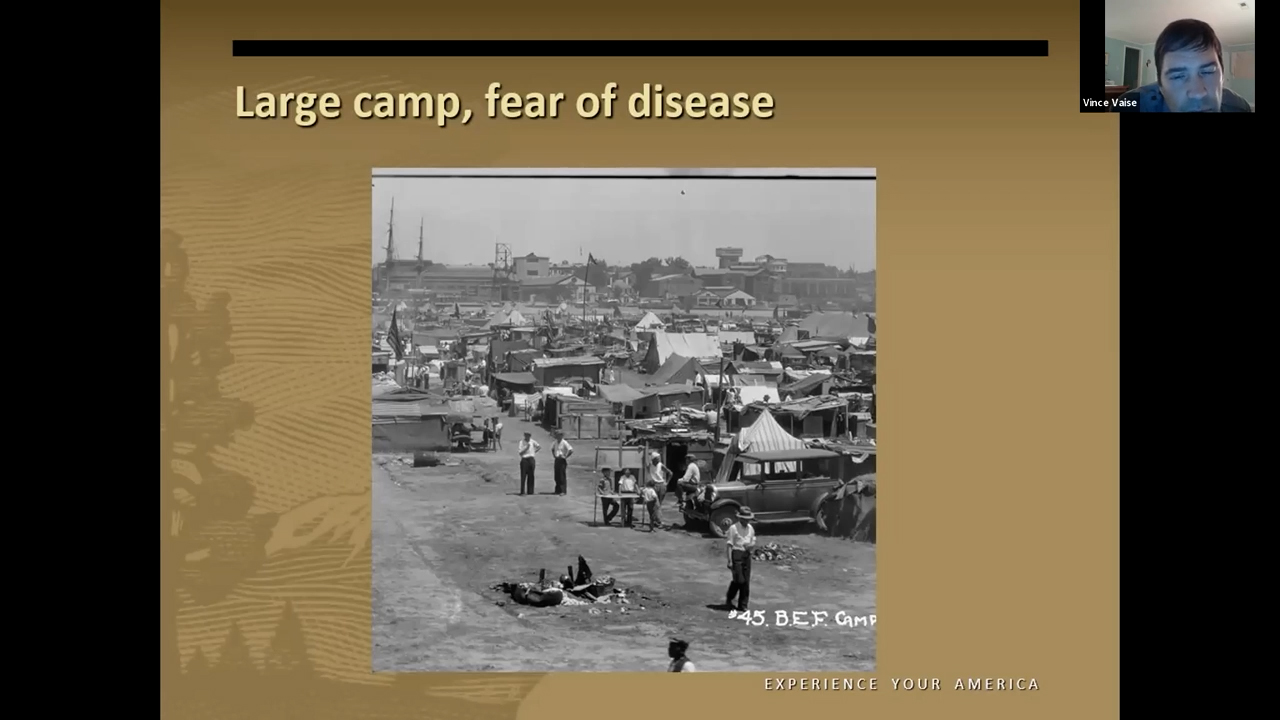
00:34:25:05 - 00:34:48:16
Vince Vaise
All that’s going to happen is there's going to be violence or someone's going to get sick. Something's going to go wrong. There was also a little bit of unrest within the veterans. This is Walter W. Waters here in the front, and he starts getting a faction - not all of them, not even most of them, but a faction - of the Bonus Army to start wearing khaki shirts.

00:34:48:16 - 00:35:07:15
Vince Vaise
And he starts calling his little faction “The Khaki Shirts” and seeing himself as, like, a little miniature Mussolini kind of thing, you know, kind of getting a little bit big for his britches. Like, “I brought these veterans to D.C. and I can make them do whatever I want them to do. And you better, you better do what I say.
00:35:07:15 - 00:35:39:04
Vince Vaise
Or we might take matters into our own hands.” So the tension was really kind of starting to build here. Tension - this spilled over when the police were ordered to force the evacuation of veterans camped near the Capitol building. So this photo is not from the Anacostia encampment. It's from the encampment near the Capitol building. And it was just, you know, a little bit of a fight that broke out, a few bloody noses.
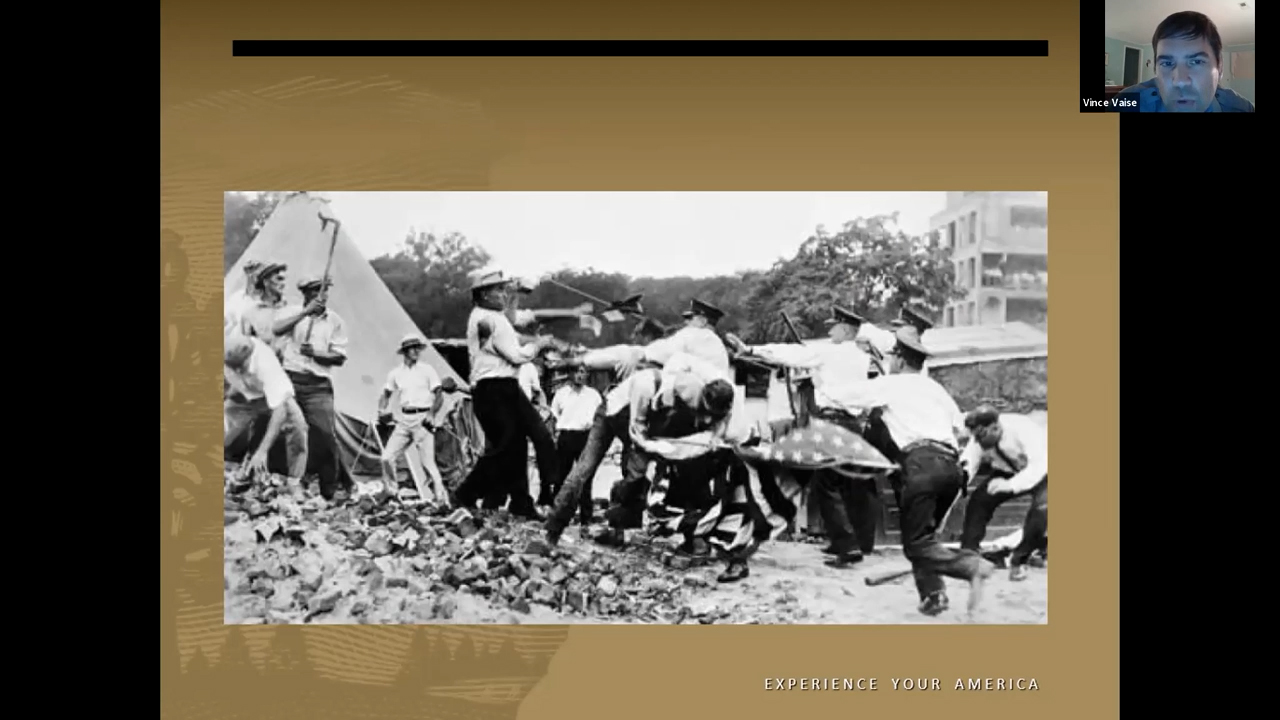
00:35:39:06 - 00:35:59:00
Vince Vaise
One of the police actually calms everyone down saying, hey, why don't we just have an armistice of this scuffle? And everyone kind of laughed and it kind of broke the tension. But then later on, it broke out again when they were trying to evict some veterans, one threw a garbage can filled with bricks at a cop from a second-story window.
00:35:59:02 - 00:36:25:21
Vince Vaise
Gunshots were fired. One of the policemen - the police fired back. A couple of police were killed. And then the army was called, and now - the army was kind of on standby because, like I said, the city leaders of Washington want these veterans gone. So they connected with the Army. They would have connected with the Marines, but they thought the Marines would side with the vets.
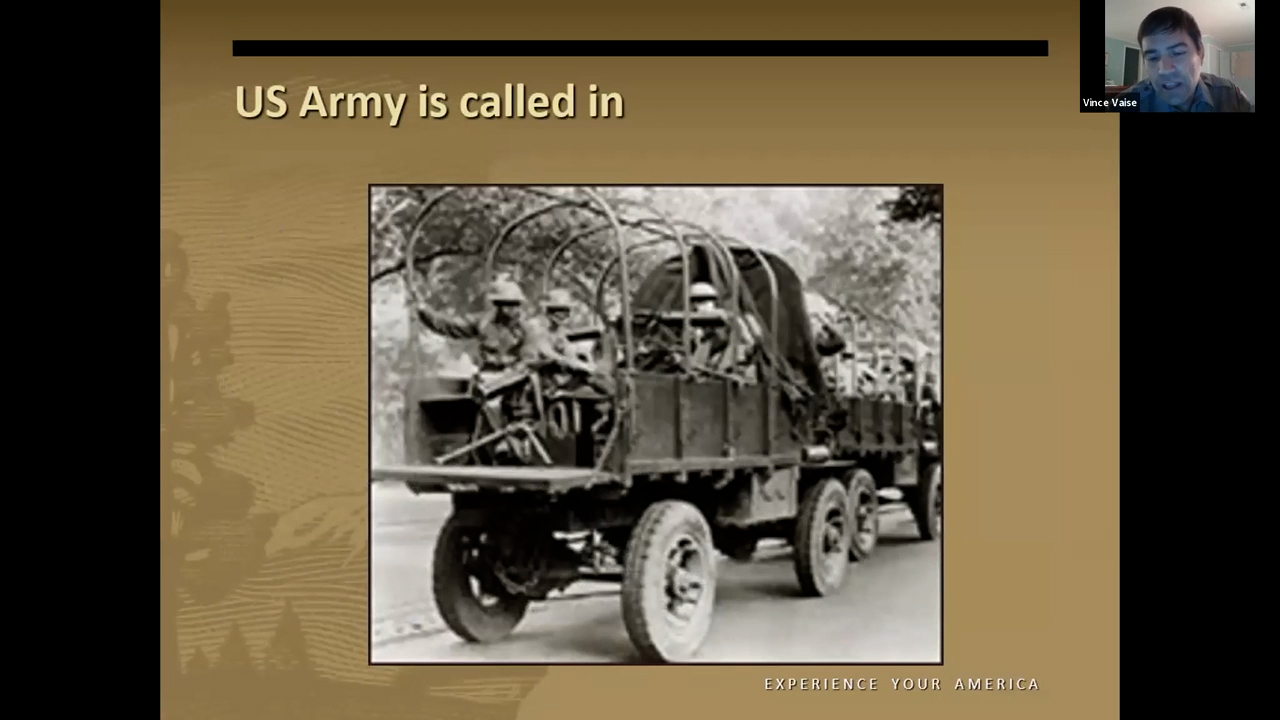
00:36:25:23 - 00:36:53:23
Vince Vaise
So that's why they went to the Army, and military personnel were brought up from Fort Washington, which is a National Park Service site today, and some from Fort Myer. General Douglas MacArthur is on hand. His aide, Major Dwight David Eisenhower, is also on hand. And MacArthur pretty well says, we're here to break the back of the Bonus Army.

00:36:54:00 - 00:37:24:02
Vince Vaise
And basically the veterans are - the initial plan is to evict all the veterans that are near the Capitol building. But not to mess with the veterans who are in Anacostia. And so, hundreds - it's actually like a force of 900 army - it's something like 600 soldiers and 300 cavalry, and six tanks.
00:37:24:04 - 00:38:09:07
Vince Vaise
And the cavalry and tanks are under another officer who would become famous, George S. Patton, who would be very famous in World War II. Patton himself was a World War I veteran. And the Army teargasses these World War I vets - how ironic, in a war that was infamous for poisonous gas that our own army teargassed its own veterans in the streets of Washington, D.C. In addition to the veterans being teargassed, spectators - thousands of them actually - wound up getting inadvertently teargassed, getting a little bit too close to the action.
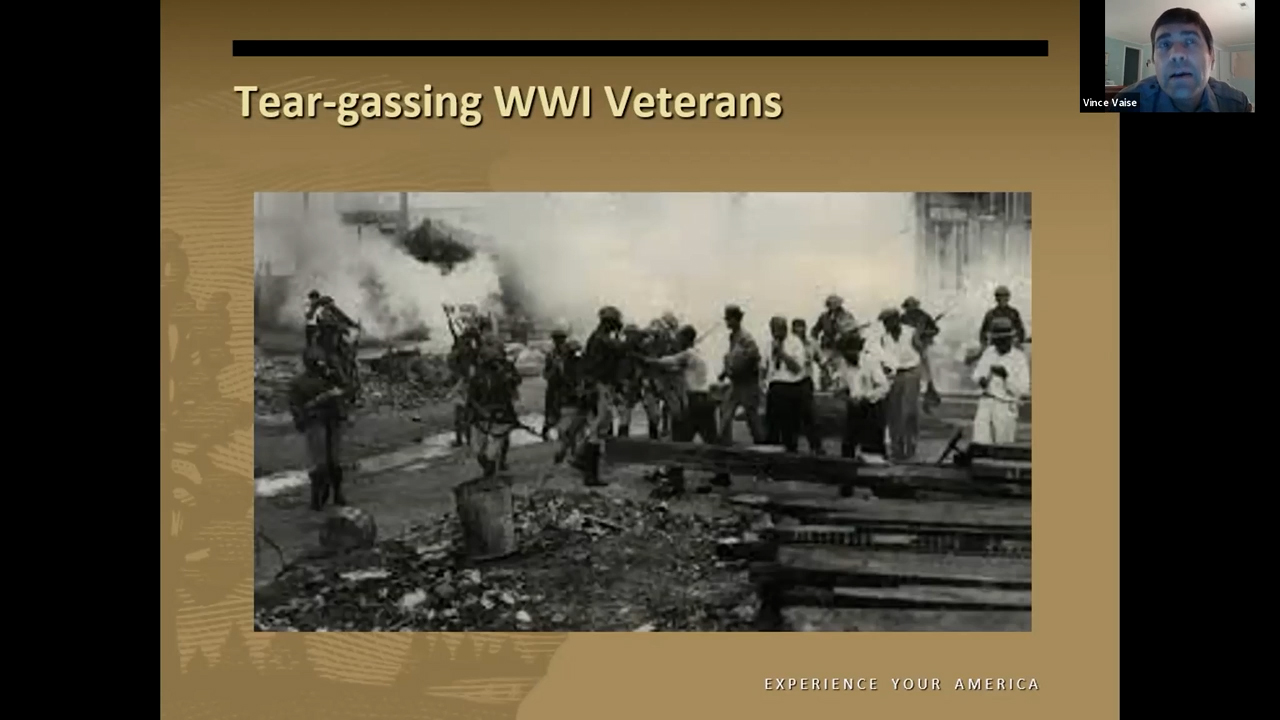
00:38:09:09 - 00:38:36:03
Vince Vaise
MacArthur is there kind of, you know, strutting his stuff, as it were. Here's another street scene, as the Army kind of moves these veterans, firing tear gas bombs and the veterans kind of shuffling away. MacArthur publicly saying, these veterans - stating that the veterans were really just communists. All of them were really communists. That was what MacArthur and a few others believed.
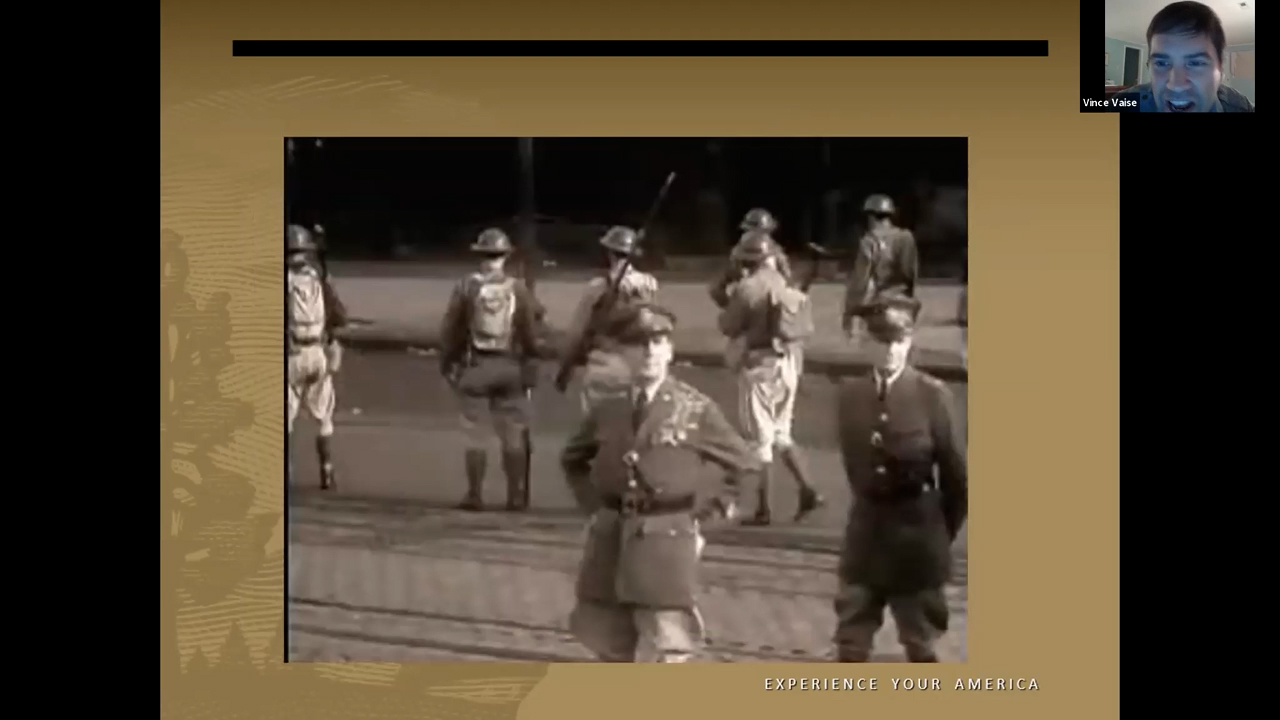

00:38:36:03 - 00:39:10:05
Vince Vaise
And here's the tanks. There's little Renault tanks there. Interestingly enough, the Army crosses the 11th Street Bridge, an aide comes up to MacArthur and basically says that, hey, the leaders of Washington, D.C. and the president, President Hoover, basically, yeah, they gave you orders to evict the veterans near the Capitol building and on the Mall, but not to cross the Navy Yard Bridge and not to evict them from Anacostia.
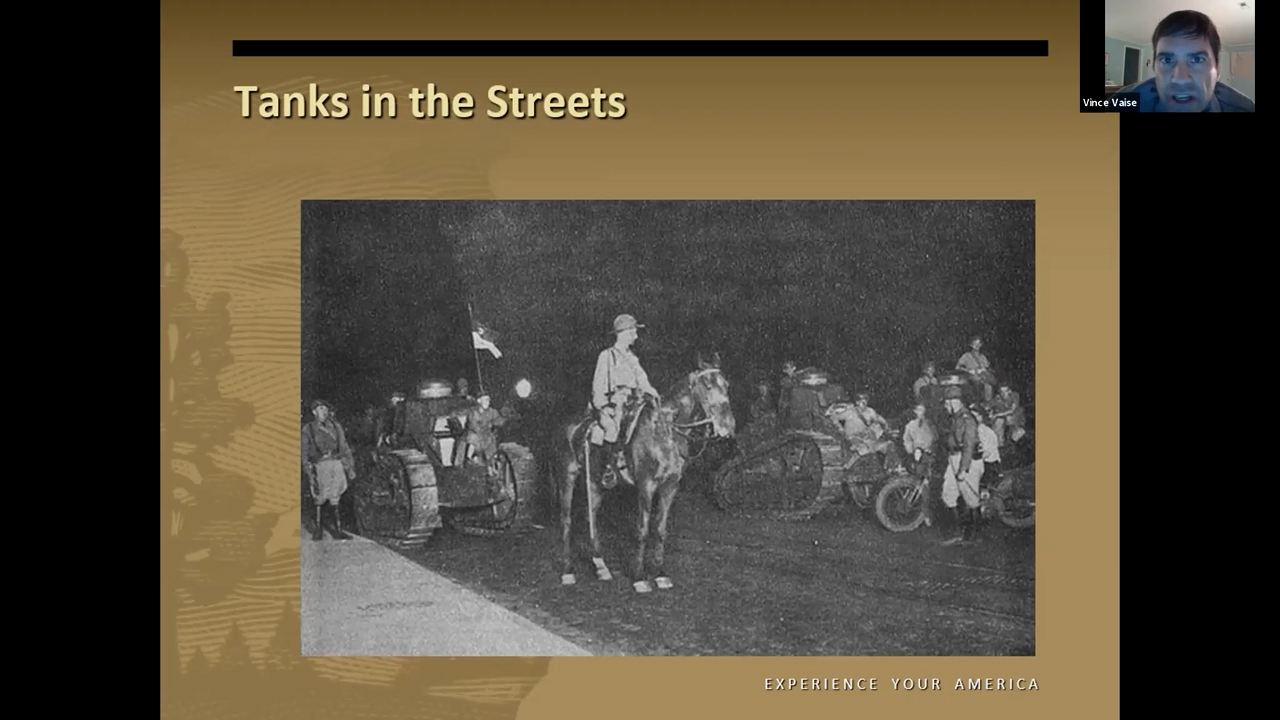
00:39:10:07 - 00:39:37:16
Vince Vaise
MacArthur bluntly replies, “I'm in the middle of a military operation. I cannot be bothered with orders from a president.” And this would not be the last time that MacArthur would ignore an order not to cross a river from a standing president. MacArthur gives the Bonus encampment one hour to get out of Anacostia, which induces pandemonium.
00:39:37:16 - 00:40:06:22
Vince Vaise
I mean, you saw how ensconced everyone was. And so there's a flurry, women and children running around. And then after an hour, tear gas is fired into the camp, and some of the soldiers start setting the tents on fire. One Bonus Army vet said that it was like running around inside a teakettle, with the smoke and everything, and thousands flee up Good Hope Road into the town of Anacostia.
00:40:06:24 - 00:40:42:10
Vince Vaise
The fire spreads, veterans flee. Fortunately, nobody is killed. Although there was a small baby that they believe died from tear gas inhalation, actually, from the town of Anacostia itself. And then the whole encampment is put to the torch. And then the next day, there's just nothing but these smoking ruins. And this is all - that was covered by the news, so you can see the desolation. It then rains and just makes the whole thing a murky mess.
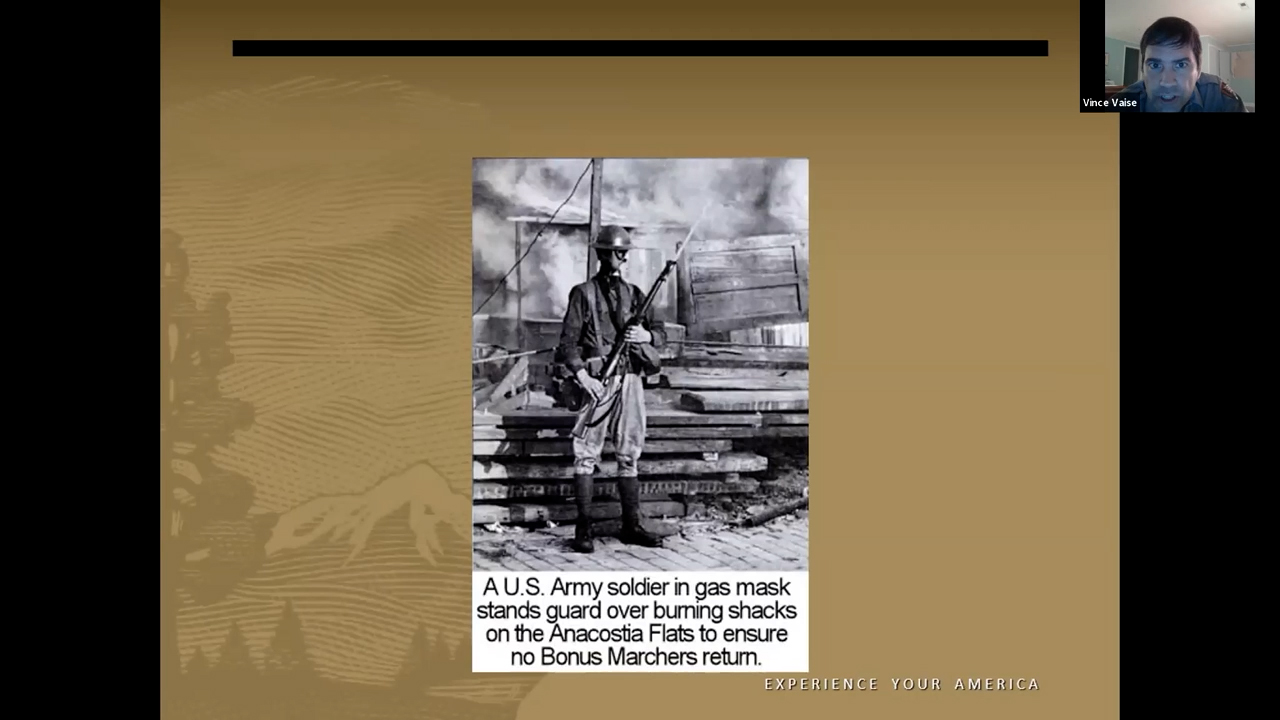

00:40:42:12 - 00:41:13:08
Vince Vaise
Interestingly enough, a coworker of mine, her father was a small five-year-old, and his dad brought him up two days after this. And he says - he's 99 years old, and he said he could still remember it. Like he could remember the smell of all the burnt canvas and everything. Patton is on the scene with some of his soldiers, and this guy, Joe Angelo, comes up to him.
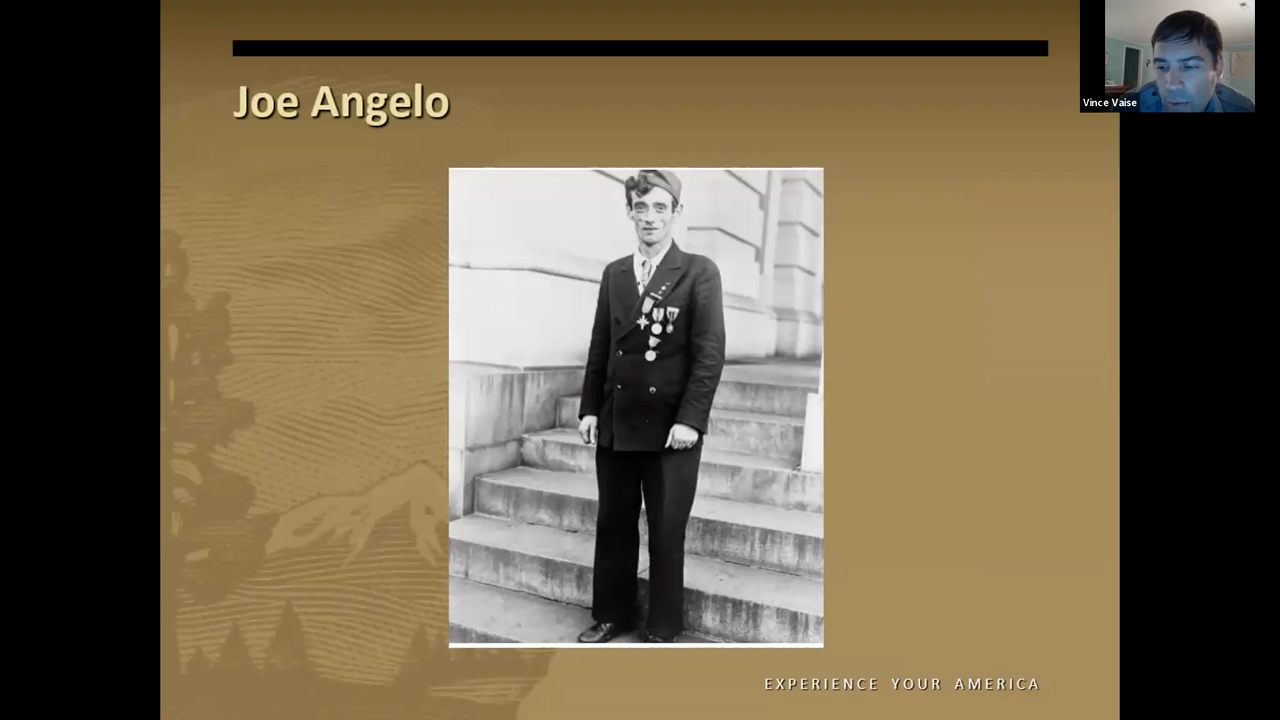
00:41:13:08 - 00:41:36:03
Vince Vaise
Angelo saved Patton’s life during World War I. Patton says brusquely, “Get that man out of here. I do not want him in my presence today.” And he's escorted out. Patton then went on to say that we've been supporting him indirectly for many years, and things like that. Needless to say, this does not make good headlines.
00:41:36:03 - 00:41:56:13
Vince Vaise
This is also probably why we don't have - oh, we make a big - this is why probably you never heard of the Bonus Army at Anacostia, but you have heard of, say, Normandy and other places where we won and the history is a lot more positive, right? But needless to say, the president really looks bad.
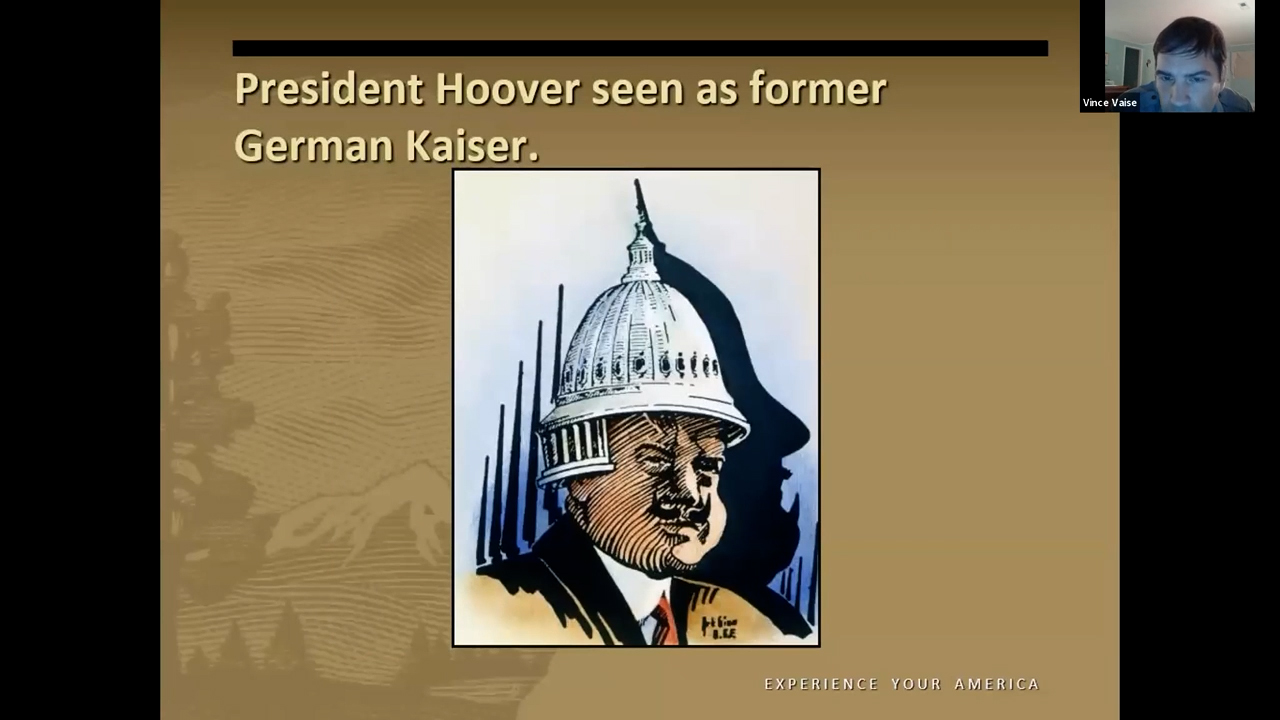
00:41:56:13 - 00:42:29:01
Vince Vaise
I mean, you can see here President Hoover is seen as the German Kaiser, the German enemy. And if Hoover wasn't hated before this, he certainly was hated afterwards. And basically, his reelection prospect goes absolutely into the tank and he loses the election. So what comes from this? Well, interestingly enough, there's talk after Franklin Delano Roosevelt is elected about resurrecting the bonus.
00:42:29:03 - 00:42:55:19
Vince Vaise
And to be fair, FDR was very much against the bonus, too. So it's not like he was any different than Hoover was. However, during World War II, basically a number of his aides and people like Marshall and others are like, look, you know, when this war is over, you might be faced with a bigger depression than Hoover had, and you might - you're going to have a lot more veterans to contend with than he did.
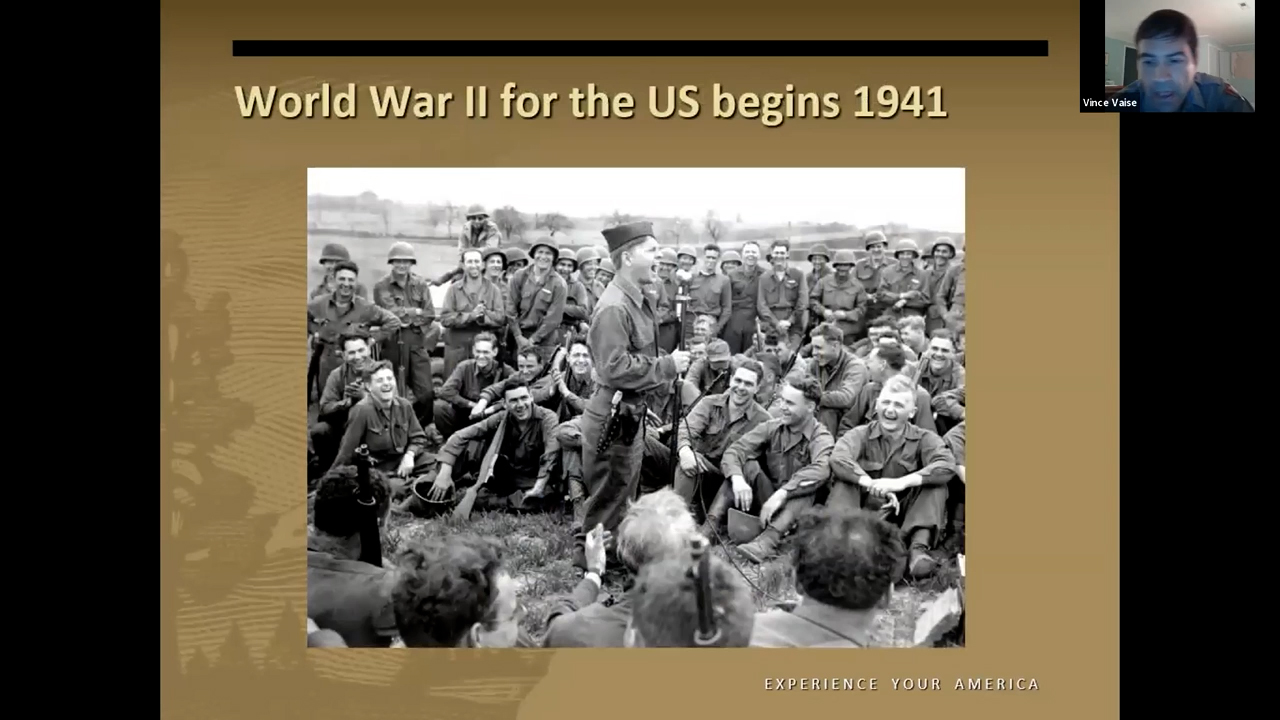
00:42:55:21 - 00:43:22:07
Vince Vaise
Don't you think we better do something to keep this from happening again? You don't want another Bonus Army on your hands. And so this is why during World War II, the G.I. Bill is devised and he would sign the G.I. Bill. Rather than having a bonus on the back end, why don't we give the vets money to go to college and education financing on the front end?
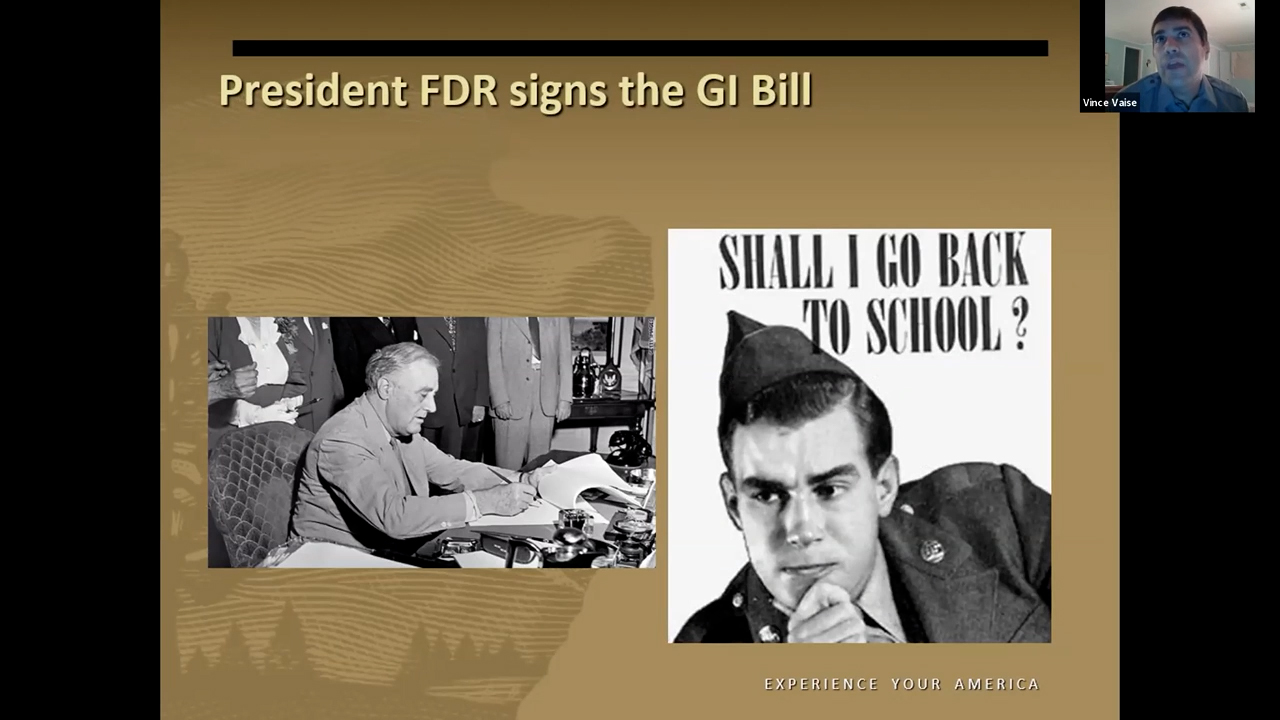
00:43:22:13 - 00:44:08:04
Vince Vaise
So when they get out, they get better jobs, they reintegrate into society quicker, they earn more and therefore we won't have a Great Depression, maybe. And also their standard of living will be higher. So we won't have an army of jobless. And that's just revolutionary. I mean, you know, there were many colleges that were initially against it, and yet they found that the veterans were more disciplined than the traditional college students, that veterans, you know, they said were not solely but certainly heavily contributed to the postwar boom after World War II thanks to the better jobs they got, thanks to the better education they received because of the G.I. Bill.
00:44:08:09 - 00:44:36:16
Vince Vaise
And it's a testimony to its effectiveness that it exists even to this day. So one of the living legacies of the Bonus Army and Anacostia is the G.I. Bill. But it gives us pause to think how we treat vets, how we respond to crises and how some of what has happened then really affects all of us today.
00:44:36:18 - 00:44:43:01
Vince Vaise
Thanks for camping with me down Anacostia for a little while there.
00:44:43:03 - 00:45:25:09
Lora Vogt
Vince, thank you so very much. As I was just sharing on Twitter, you are the history educator so many people wish they had when they were in high school so that they knew they liked history back then. Thank you so very much. And I so thoroughly appreciate your ending on that note of how these experiences of World War I not only affect what happened in World War II, but are these lessons that we can still continue to learn from today?
00:45:25:11 - 00:45:44:19
Lora Vogt
I am going to go ahead - in our few minutes left - go ahead and take some of our questions. Again, if you are joining us on Facebook Live or on Zoom, we really do welcome your questions at this point in time. If you're on Zoom, go ahead and add that into the Q&A, just like Michael Goodman did.
00:45:44:19 - 00:46:14:17
Lora Vogt
Thank you so much. And if you are on Facebook Live, go ahead and add that in to the comments there as well. So, the first question for you: do you know kind of roughly the size of the U.S. Army at the time, kind of in 1932? And how that might, how that kind of compared to the size of the Bonus Army that was there.
00:46:14:19 - 00:46:47:21
Vince Vaise
I can't give you an accurate number for the American army nationwide. However, I can say for the District of Columbia - and there's a lot of military down there - you have, you know, of course you got Fort Myer. Again, Fort Washington was a huge installation. So certainly, yeah, the Bonus Army had the regular army outnumbered. Now, of course, if you add the Marines and, and the Navy from the Navy Yard and others, there was probably about 4-5,000 U.S. military that could be brought to bear.
00:46:47:21 - 00:47:06:19
Vince Vaise
And if you reached up to, say, Fort Meade, you could probably get Maryland and other places, you could probably - and other places in Northern Virginia - you could probably double that pretty quickly. And the Bonus Army were unarmed, but nevertheless, you know, 18,000 people - guys in one spot - that was a lot. That was a force.
00:47:06:21 - 00:47:15:11
Lora Vogt
Yeah, absolutely. Did the G.I. Bill of World War II only apply to white soldiers? A good question from -
00:47:15:11 - 00:47:34:03
Vince Vaise
I looked into that. Yeah, I do this tour on a bike tour. And I got that question. It did not. African Americans could qualify for the G.I. Bill. The problem was, though, a lot of colleges did not want to admit African Americans. So that's where the issue was.
00:47:34:05 - 00:47:43:17
Lora Vogt
Did Eleanor Roosevelt meet with one of the later groups of Bonus marchers? That is a really specific question.
00:47:43:19 - 00:47:53:19
Vince Vaise
That is. I will have to look into that. I would probably say yes. However, I would want to check my facts on that before locking that down.
00:47:53:21 - 00:47:56:08
Lora Vogt
Because you are a good historian. Clearly.
00:47:56:10 - 00:48:04:21
Vince Vaise
And there were little aftershocks of, like, mini Bonus Armies that came up, but nothing was anywhere close to the summer of ‘32.
00:48:04:23 - 00:48:17:10
Lora Vogt
Okay. And then I'm going to check here - are there - from Matt Barrett online at Facebook Live - are there any specific books or essays on this topic that you might recommend?
00:48:17:13 - 00:48:44:16
Vince Vaise
Yeah. And you can get at your local library - the best one that that I've seen is this one here, “The Bonus Army” by Paul Dickinson and Thomas Allen. And it's a really good read. I mean, it reads like you're there. He's got good maps. And it just is really powerful narrative history. I mean, there's a lot more detail that I didn't have time for today.
00:48:44:16 - 00:48:59:19
Vince Vaise
There's - a lot of the vets went to Johnstown, Pennsylvania, and lived there for a little while. There's a lot of neat, neat history. “The Bonus Army: An American Epic.” Paul Dickinson and Thomas Allen.
00:48:59:23 - 00:49:19:01
Lora Vogt
Outstanding. Now, a quick question for you. (I'm going to switch our slides here really quickly.) Is there a - are you all open, in that space - if someone is in and around your area, are the national park spaces open?
00:49:19:03 - 00:49:44:06
Vince Vaise
Yes. The spaces are open by the - like if you go to Anacostia, it's open. You can walk the fields where the Bonus Army camped. Our aquatic garden is open. You can walk the National Mall. However, a lot of the historic homes like the Frederick Douglass House, those that have very narrow passageways and small rooms, they're still closed.
00:49:44:08 - 00:50:00:23
Vince Vaise
The Washington Monument, though, is officially open. However, it is open on a limited thing. Like you have to get special reservations, they’re not taking as many people as they used to. So we're doing what we can, but we still got to keep everyone safe.
00:50:01:00 - 00:50:31:05
Lora Vogt
Absolutely. That is - it is one of the lessons that all historians of World War I can agree to, which is do what you can to protect from the flu, and get a flu shot. That is somebody else's joke. Michael - Doctor Michael Neiberg, that's a shout-out to you. But I use it often, and, well, historians notably constantly argue, but truly, across the board they all do kind of agree on that thing.
00:50:31:05 - 00:50:51:09
Lora Vogt
So I would say you have a lot of support from your World War I historians. Now, if you are in and around the D.C. area, we would encourage you to go take a look at Pershing Park. It is very near the White House. It is also the location of your National World War I Memorial located in Washington, D.C.
00:50:51:09 - 00:51:14:10
Lora Vogt
It is now scheduled to open in December. That is part and parcel of the project of the World War I Centennial Commission with whom we are partnering for this and other events within “World War I Changed Us” series, but also throughout the centennial of World War I, and a lot of our educational resources.
00:51:14:16 - 00:51:44:07
Lora Vogt
If you are not in and around D.C., you can find out more about this new memorial, which means that World War I will be the only war inside the United States that has two national memorials. Which says something as well to the importance that it has for our present. Check out there a virtual explorer at ww1cc.org.
00:51:44:13 - 00:52:16:17
Lora Vogt
We also worked with them on an educational resource. Whether or not you are a free choice learner on your own accord, or if you specifically are a teacher you can head to WWIChangedUS.org. There are short videos - seven minutes or less - podcasts and teaching resources including lesson plans and primary source activities, that look at the American history side of it, including looking at what it was like to be coming home.
00:52:16:19 - 00:52:50:07
Lora Vogt
And you can see there - video, primary source, lesson plan and podcast. Again, it's at WWIChangedUS.org. It's a nice transition point into, yes, this lecture, and the ways that - if you are a teacher - this very event, we have transformed what you talk about in your classroom, whether that's actually onsite or whether that is online. We also have available online exhibitions like “Make Way for Democracy” on Google Arts and Culture.
00:52:50:09 - 00:53:14:20
Lora Vogt
And, in partnership with not only the World War I Centennial Commission, but a wide array of other organizations including the National Park Service, we highlight some of the very best resources about World War I and its enduring impact. And I can actually promise you all this: if you really haven't dug into the National Park Service's resources, their
00:53:14:20 - 00:53:38:22
Lora Vogt
historians are spectacular. Do spend a little time - it is a rabbit hole of incredible history. And jump on into those spaces to learn more about the history of this nation. We highlight some of those that interconnect with World War I right here on our resource database, along with National History Day, National Archives, and a variety of other sources.
00:53:38:24 - 00:54:07:07
Lora Vogt
Your one stop searchable shop for educational resources that hopefully are going to be helpful to you - again, whether you are onsite, online, or however you are managing to keep your sanity teaching this year. We are so appreciative and so supportive of what you are doing. Every other month we send out a newsletter, again in partnership with the World War I Centennial Commission. And on our website, theworldwar.org,
00:54:07:07 - 00:54:41:22
Lora Vogt
we've got an online collections database of over 40,000 digitized images that puts research and resources at your fingertips. And during COVID, our organization shifted because we were no longer open to the public between March 15th and June 1st. So everyone who was working with the public and our visitors switched to transcribing, and there are 12,000 new pages of transcribed letters and documents and diaries.
00:54:41:22 - 00:55:11:07
Lora Vogt
And it is spectacular. That is another incredible space to take a look at. And you'll find things like this right here, the Bonus Expeditionary Force ribbon, among 39,999+ other things. Now, if you're a teacher and you're here for professional development, the password for tonight is BonusMarch1932. We’ll have a link attached to our YouTube recording of this.
00:55:11:07 - 00:55:41:10
Lora Vogt
If you're catching us later, it will also be sent out to all of you who signed up on Zoom in your evaluation survey that will be coming tomorrow, or later this evening, as the case might be. But we certainly appreciate your evaluations. Those things help us give reports back to funders. And, as you know, nonprofits and education spaces always appreciate those who are willing to support them.
00:55:41:10 - 00:56:03:19
Lora Vogt
Now, I'm going to take a very fast look and make sure...You have other questions, but we might have to send them to you because I'm looking and I see that we are run out of time right now. What a delightful opportunity. And I'm going to actually leave you guys with this last moment right here.
00:56:03:21 - 00:56:30:18
Lora Vogt
To repeat some of what Ranger Vaise said here about the importance of the Bonus Army, and people coming together, and how these (primarily) men used the lessons that they learned during the war to move forward to create a community and to fight for something that they thought was important for the nation.
00:56:30:20 - 00:56:58:12
Lora Vogt
What was inscribed on the base of our memorial, actually just a few years after the Bonus March, was these words - also brought from President Lincoln's second inaugural address. “These have dared bear the torches of sacrifice and service: Their bodies are turned to dust, but their work liveth forevermore. Let us strive on to do all which may achieve and cherish a just and lasting peace among ourselves and with all nations.”
00:56:58:14 - 00:57:22:12
Lora Vogt
And in a time that seems very polarized, and in a time that also harkens back to pandemics and protests and other presidential elections, as you were mentioning, this is what the people of the past wanted us to consider. This is that take-action moment: to create, to achieve and to cherish a just and lasting peace among ourselves and with all nations.
00:57:22:14 - 00:57:41:04
Lora Vogt
We deeply believe that learning history is where you start in doing just that thing. Thank you all so much for being journey-mates and learning on this episode of “World War I Changed Us.” Have a wonderful rest of your day.
